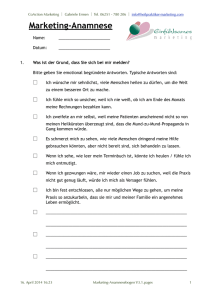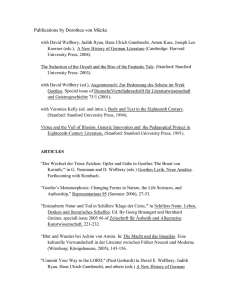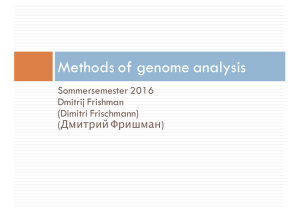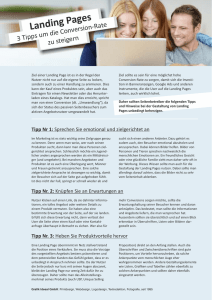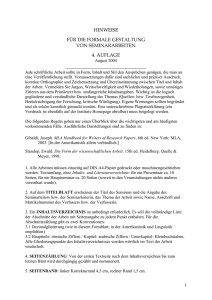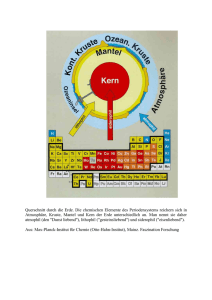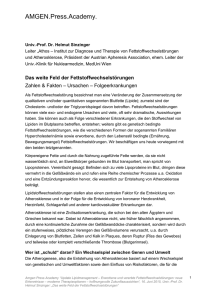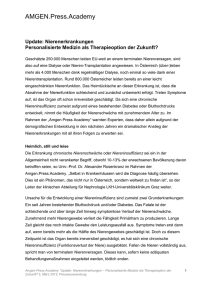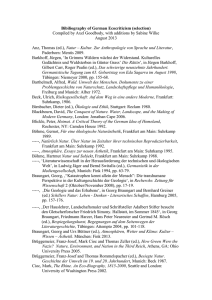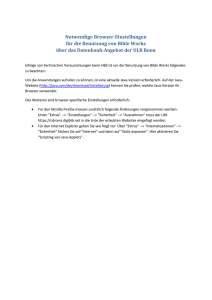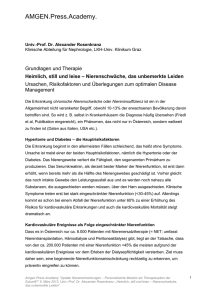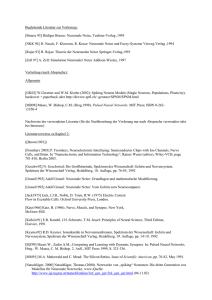MaierZionBibliography-USLetter - Uni
Werbung
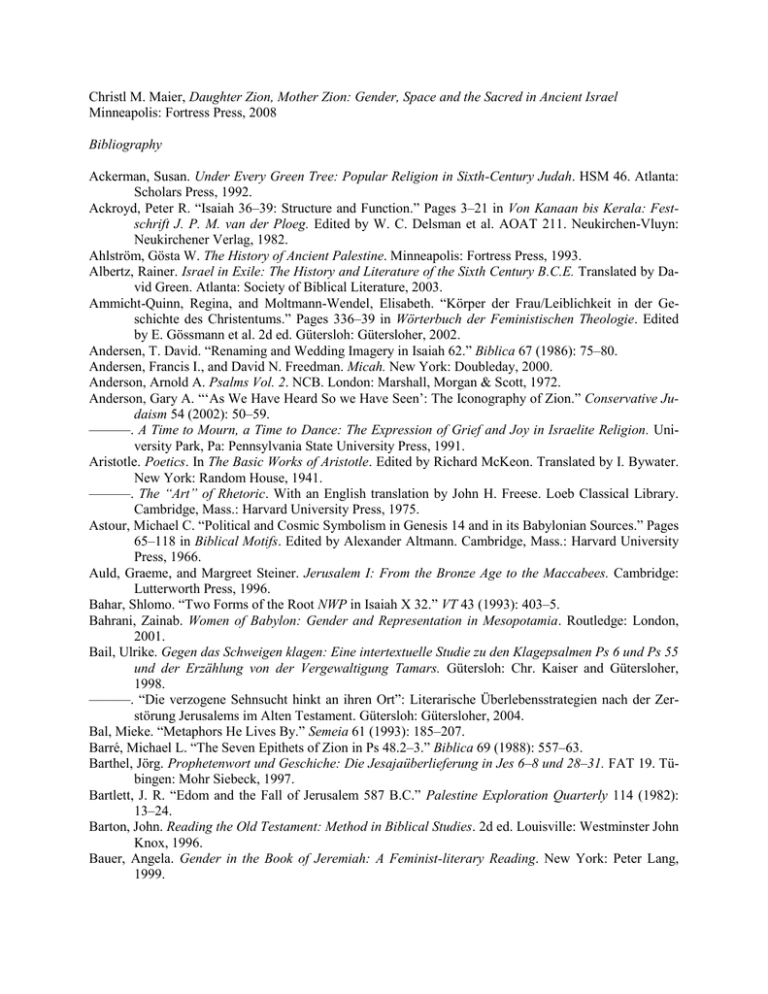
Christl M. Maier, Daughter Zion, Mother Zion: Gender, Space and the Sacred in Ancient Israel Minneapolis: Fortress Press, 2008 Bibliography Ackerman, Susan. Under Every Green Tree: Popular Religion in Sixth-Century Judah. HSM 46. Atlanta: Scholars Press, 1992. Ackroyd, Peter R. “Isaiah 36–39: Structure and Function.” Pages 3–21 in Von Kanaan bis Kerala: Festschrift J. P. M. van der Ploeg. Edited by W. C. Delsman et al. AOAT 211. Neukirchen-Vluyn: Neukirchener Verlag, 1982. Ahlström, Gösta W. The History of Ancient Palestine. Minneapolis: Fortress Press, 1993. Albertz, Rainer. Israel in Exile: The History and Literature of the Sixth Century B.C.E. Translated by David Green. Atlanta: Society of Biblical Literature, 2003. Ammicht-Quinn, Regina, and Moltmann-Wendel, Elisabeth. “Körper der Frau/Leiblichkeit in der Geschichte des Christentums.” Pages 336–39 in Wörterbuch der Feministischen Theologie. Edited by E. Gössmann et al. 2d ed. Gütersloh: Gütersloher, 2002. Andersen, T. David. “Renaming and Wedding Imagery in Isaiah 62.” Biblica 67 (1986): 75–80. Andersen, Francis I., and David N. Freedman. Micah. New York: Doubleday, 2000. Anderson, Arnold A. Psalms Vol. 2. NCB. London: Marshall, Morgan & Scott, 1972. Anderson, Gary A. “‘As We Have Heard So we Have Seen’: The Iconography of Zion.” Conservative Judaism 54 (2002): 50–59. ———. A Time to Mourn, a Time to Dance: The Expression of Grief and Joy in Israelite Religion. University Park, Pa: Pennsylvania State University Press, 1991. Aristotle. Poetics. In The Basic Works of Aristotle. Edited by Richard McKeon. Translated by I. Bywater. New York: Random House, 1941. ———. The “Art” of Rhetoric. With an English translation by John H. Freese. Loeb Classical Library. Cambridge, Mass.: Harvard University Press, 1975. Astour, Michael C. “Political and Cosmic Symbolism in Genesis 14 and in its Babylonian Sources.” Pages 65–118 in Biblical Motifs. Edited by Alexander Altmann. Cambridge, Mass.: Harvard University Press, 1966. Auld, Graeme, and Margreet Steiner. Jerusalem I: From the Bronze Age to the Maccabees. Cambridge: Lutterworth Press, 1996. Bahar, Shlomo. “Two Forms of the Root NWP in Isaiah X 32.” VT 43 (1993): 403–5. Bahrani, Zainab. Women of Babylon: Gender and Representation in Mesopotamia. Routledge: London, 2001. Bail, Ulrike. Gegen das Schweigen klagen: Eine intertextuelle Studie zu den Klagepsalmen Ps 6 und Ps 55 und der Erzählung von der Vergewaltigung Tamars. Gütersloh: Chr. Kaiser and Gütersloher, 1998. ———. “Die verzogene Sehnsucht hinkt an ihren Ort”: Literarische Überlebensstrategien nach der Zerstörung Jerusalems im Alten Testament. Gütersloh: Gütersloher, 2004. Bal, Mieke. “Metaphors He Lives By.” Semeia 61 (1993): 185–207. Barré, Michael L. “The Seven Epithets of Zion in Ps 48.2–3.” Biblica 69 (1988): 557–63. Barthel, Jörg. Prophetenwort und Geschiche: Die Jesajaüberlieferung in Jes 6–8 und 28–31. FAT 19. Tübingen: Mohr Siebeck, 1997. Bartlett, J. R. “Edom and the Fall of Jerusalem 587 B.C.” Palestine Exploration Quarterly 114 (1982): 13–24. Barton, John. Reading the Old Testament: Method in Biblical Studies. 2d ed. Louisville: Westminster John Knox, 1996. Bauer, Angela. Gender in the Book of Jeremiah: A Feminist-literary Reading. New York: Peter Lang, 1999. C.M. Maier, Daughter Zion, Mother Zion — Bibliography 2 Baumann, Gerlinde. Gottesbilder der Gewalt im Alten Testament verstehen. Darmstadt: Wissenschaftliche Buchgesellschaft, 2006. ———. Love and Violence: Marriage as Metaphor for the Relationship between YHWH and Israel in the Prophetic Books. Translated by Linda M. Maloney. Collegeville, Minn.: Liturgical Press, 2003. Bechtel, Lyn. "Rethinking the Interpretation of Genesis 2:4b–3:24.” Pages 77–117 in A Feminist Companion to Genesis. Edited by Athalya Brenner. Sheffield: Sheffield Academic Press, 1993. Repr., 1997. Berges, Ulrich. Das Buch Jesaja: Komposition und Endgestalt. HBS 16. Freiburg: Herder, 1998. ———. Deutero-Jesaja (Jes 40–48). HTKAT, Freiburg: Herder, 2008. ———. Klagelieder. HTKAT, Freiburg: Herder, 2002. ———. “Personifications and Prophetic Voices of Zion in Isaiah and Beyond.” Pages 54–82 in The Elusive Prophet: The Prophet as a Historical Person, Literary Character and Anonymous Artist. Edited by Johannes C. de Moor. Oudtestamentische Studiën 45. Leiden: Brill, 2001. ———.“Die Zionstheologie des Buches Jesaja.” Estudios Bíblicos 58 (2000): 167–98. Berlin, Adele. Lamentations: A Commentary. OTL. Louisville: Westminster John Knox, 2002. Berquist, Jon L. “Critical Spatiality and the Construction of the Ancient World.” Pages 14–29 in ‘Imagining’ Biblical Worlds: Studies in Spatial, Social and Historical Constructs in Honor of James W. Flanagan. Edited by D. M. Gunn and P. M. McNutt. JSOTSup 359. Sheffield: Sheffield Academic Press, 2002. ———, and James W. Flanagan. “Ancient Perceptions of Space/Perceptions of Ancient Space.” Semeia 87 (1999): 15–43. Best, Steven, and Douglas Keller. Postmodern Theory: Critical Interrogations. New York: Guilford Press, 1991. Best, Sue. “Sexualizing Space.” Pages 181–194 in Sexy Bodies: The Strange Carnalities of Feminism. Edited by Elizabeth Grosz and Elspeth Probyn. London: Routledge, 1995. Beuken, Willem A. M. “Isaiah Chapter LXV–LXVI: Trito-Isaiah and the Closure of the Book of Isaiah.” Pages 204–21 in Congress Volume Leuven 1989. Edited by John A. Emerton. VTSup 43. Leiden: Brill, 1991. ———. “Isaiah LIV: The Multiple Identity of the Person Addressed.” Pages 29–70 in Language and Meaning: Studies in Hebrew Language and Biblical Exegesis. Edited by James Barr et al. Oudtestamentische Studiën 19. Leiden: Brill, 1974. ———.“Jesaja 33 als Spiegeltext im Jesajabuch.” ETL 67 (1991): 5–35. ———. “The Literary Emergence of Zion as a City in the first Opening of the Book of Isaiah (1,1–2,5).” Pages 457–70 in Gott und Mensch im Dialog: Festschrift für Otto Kaiser, vol. I. Edited by Markus Witte. BZAW 345/I. Berlin: De Gruyter, 2004. ———. “The Main Theme of Trito-Isaiah: The ‘Servants of YHWH’.” JSOT 47 (1990): 67–87. ———. “The Manifestation of Yahweh and the Commission of Isaiah: Isaiah 6 Read Against the Background of Isaiah 1.” Calvin Theological Journal 39 (2004): 72–87. ———. “Servant and Herald of Good Tidings: Isaiah 61 as an Interpretation of Isaiah 40–55.” Pages 411– 42 in The Book of Isaiah/Le livre d’Isaïe. BETL 81. Leuven: Leuven University Press, 1989. Betz, Hans Dieter et al., eds. Religion in Geschichte und Gegenwart. 4th ed. 8 vols. Tübingen: Mohr Siebek, 1998–2005. Biddle, Mark E. “The Figure of Lady Jerusalem: Identification, Deification and Personification of Cities in the Ancient Near East.” Pages 173–94 in The Biblical Canon in Comparative Perspective: Scripture in Context IV. Edited by K. Lawson Younger, William W. Hallo, Bernard F. Batto. Lewiston, N.Y.: Edwin Mellen Press, 1991. ———. “Lady Zion’s Alter Egos: Isaiah 47.1–15 and 57.6–13 as Structural Counterparts.” Pages 124–139 in New Visions of Isaiah. Edited by Roy F. Melugin and Marvin A. Sweeney. JSOTSup 214. Sheffield: Sheffield Academic Press, 1996. Binger, Tilde. “Fighting the Dragon: Another Look at the Theme in the Ugaritic Texts.” SJOT 6 (1992): 139–49. C.M. Maier, Daughter Zion, Mother Zion — Bibliography 3 Bird, Phyllis A. “The Harlot as Heroine: Narrative Art and Social Presupposition in Three Old Testament Texts.” Pages 197–218 in Missing Persons and Mistaken Identities: Women and Gender in Ancient Israel. Minneapolis: Fortress Press, 1997. ———. “To Play the Harlot: an Inquiry into an Old Testament Metaphor.” Pages 75–94 in Gender and Difference in Ancient Israel. Edited by Peggy L. Day. Minneapolis: Fortress Press, 1989. Black, J. A. “A-Še-er Gi6-ta, a balag of Inanna.” Acta Sumerologica 7 (1985): 11–87. Black, Max. Models and Metaphors: Studies in Language and Philosophy. Ithaca: Cornell University Press, 1962. Blenkinsopp, Joseph. Isaiah 1–39. AB 19. New York: Doubleday, 2000. ———. Isaiah 40–55. AB 19A. New York: Doubleday, 2000. ———. Isaiah 56–66. AB 19B. New York: Doubleday, 2003. ———. “A Jewish Sect of the Persian Period.” CBQ 52 (1990): 5–20. Block, Daniel I. The Book of Ezekiel: Chapters 1–24. NICOT. Grand Rapids: Eerdmans, 1997. Bloedhorn, Hanswulf, and Klaus Bieberstein. Jerusalem: Grundzüge der Baugeschichte vom Chalkolithikum bis zur Frühzeit der osmanischen Herrschaft I. Beihefte zum Tübinger Atlas des Vorderen Orients B 100. Wiesbaden: Harrasowitz, 1994. Blum, Erhard. “Jesajas prophetisches Testament: Beobachtungen zu Jes 1–11.” ZAW 108 (1996): 547–68; 109 (1997): 12–29. Börker-Klähn, Jutta. “Mauerkronenträgerinnen.” Pages 227–234 in Assyrien im Wandel der Zeiten: XXXIXe Rencontre Assyriologique Internationale, Heidelberg, 6.–10. Juli 1992. Edited by Hartmut Waetzoldt and Harald Hauptmann. Heidelberger Studien zum Alten Orient 6. Heidelberg: Heidelberger Orientverlag, 1997. Booij, Theodor. “Some Observations on Psalm LXXXVII.” VT 37 (1987): 16–25. Bordo, Susan. Unbearable Weight: Feminism, Western Culture, and the Body. Berkeley: University of California Press, 1993. Borger, Rykle. Babylonisch-assyrische Lesestücke. 2 vols. Analecta Orientalia 54. 2d ed. Rome: Pontifical Biblical Institute, 1994. Botterweck, G. Johannes, Helmer Ringgren, and Heinz-Josef Fabry, eds. Theological Dictionary of the Old Testament. 14 vols. Grand Rapids: Eerdmans, 1975–2004. Braidotti, Rosi. Nomadic Subjects: Embodiment and Sexual Difference in Contemporary Feminist Theory. New York: Columbia University Press, 1994. Braun-Holzinger, Eva A. “Zikkurat.” RGG4 8:1859–60. Brenner, Athalya. “On ‘Jeremiah’ and the Poetics of Pornography.” Pages 177–93 in On Gendering Texts: Female and Male Voices in the Hebrew Bible. Edited by Athalya Brenner and Fokkelien van Dijk-Hemmes. Leiden: Brill, 1993. ———. “On Prophetic Propaganda and the Politic of ‘Love’: The Case of Jeremiah.” Pages 256–74 in A Feminist Companion to the Latter Prophets. Edited by Athalya Brenner. Sheffield: Sheffield Academic Press, 1995. Brettler, Marc. God is King: Understanding an Israelite Metaphor. JSOTSup 76. Sheffield: Sheffield Academic Press, 1989. Briggs, Charles A. A Critical and Exegetical Commentary on the Book of Psalms Vol. I. ICC. Edinburgh: T&T Clark, 1960. Briggs Charles A., and Emilie G. Briggs. A Critical and Exegetical Commentary on the Book of Psalms Vol. II. ICC. Edinburgh: T&T Clark, 1960. Bright, John. Jeremiah. AB 21. 2d ed. Garden City: Doubleday, 1965. Brown, S. Kent. “Souls, Preexistence of.” ABD 6:161. Butler, Judith. Bodies That Matter: On the Discursive Limits of ‘Sex.’ New York: Routledge, 1993. ———. Gender Trouble: Feminism and the Subversion of Identity. New York: Routledge, 1989. Cahill, Jane M. “Jerusalem in the Time of the United Monarchy.” Pages 13–80 in Jerusalem in Bible and Archaeology: The First Temple Period. Edited by Andrew G. Vaughn and Ann E. Killebrew. Atlanta: Society of Biblical Literature, 2003. C.M. Maier, Daughter Zion, Mother Zion — Bibliography 4 Camp, Claudia V. “Metaphor in Feminist Biblical Interpretation: Theoretical Perspectives.” Semeia 61 (1993): 3–36. ———. “Storied Space, or Ben Sira ‘Tells’ a Temple.” Pages 64–80 in ‘Imagining’ Biblical Worlds: Studies in Spatial, Social and Historical Constructs in Honor of James W. Flanagan. Edited by David M. Gunn and Paula M. McNutt. JSOTSup 359. Sheffield: Sheffield Academic Press, 2002. Camp, Claudia V. and Jon L. Berquist, eds. Constructions of Space I: Theory, Geography, and Narrative. Edinburgh: T&T Clark, forthcoming. ———. eds. Constructions of Space II: The Biblical City and Other Imagined Spaces. Edinburgh: T&T Clark, forthcoming. Carr, David M. “Reading Isaiah from Beginning (Isaiah 1) to End (Isaiah 65–66): Multiple Modern Possibilities.” Pages 188–218 in New Visions of Isaiah. Edited by Roy F. Melugin and Marvin A. Sweeney. JSOTSup 214. Sheffield: Sheffield Academic Press, 1996. ———. Writing on the Tablet of the Heart: Origins of Scripture and Literature. Oxford: Oxford University Press, 2005. Carroll, Robert P. Jeremiah: A Commentary. OTL. Philadelphia: Westminster, 1986. ———. “Whorusalamin: A Tale of Three Cities as Three Sisters.” Pages 67–82 in On Reading Prophetic Texts: Gender-Specific and Related Studies in Memory of Fokkelien van Dijk-Hemmes. Edited by Bob Becking and Meindert Dijkstra. Leiden: Brill, 1996. Chapman, Cynthia R. The Gendered Language of Warfare in the Israelite-Assyrian Encounter. HSM 62. Winona Lake: Eisenbrauns, 2004. Chidester, David. “The Poetics and Politics of Sacred Space: Towards a Critical Phenomenology of Reli gion.” Pages 211–31 in From the Sacred to the Divine: A New Phenomenological Approach. Edited by A.-T. Tymieniecka. Analecta Husserliana 43. Dordrecht: Kluwer Academic Publishers, 1994. Childs, Brevard S. Isaiah. OTL. Louisville: Westminster John Knox, 2001. ———. Isaiah and the Assyrian Crisis. London: SCM Press, 1967. Christensen, D. L. “The March of Conquest in Isaiah X 27c–34.” VT 26 (1976): 385–99. Cicero, De Oratore. Book III. With an English translation by H. Rackham. Loeb Classical Library. Cambridge, Mass.: Harvard University Press, 1960. Cixous, Hélène. “The Laugh of Medusa.” Signs 1:4 (1976): 875–93. Clements, Ronald E. Ezekiel. Louisville: Westminster John Knox, 1996. ———. Isaiah 1–39. NCB. Grand Rapids: Eerdmans, 1980. ———. Isaiah and the Deliverance of Jerusalem: A Study of the Interpretation of Prophecy in the Old Testament. Sheffield: JSOT Press, 1980. ———. Jeremiah. Interpretation. Atlanta: John Knox Press, 1998. ———. “The Unity of the Book of Isaiah.” Interpretation 36 (1982): 117–29. ———. Review of G. Wanke, Die Zionstheologie der Korachiten. The Journal of Theological Studies 20 (1969): 263–64. ———. “Zion as Symbol and Political Reality: A Central Isaianic Quest.” Pages 3–17 in Studies in the Book of Isaiah: Festschrift Willem A. M. Beuken. Edited by Jacques van Ruiten and Marc Vervenne. BETL 132. Leuven: Leuven University Press and Uitgeverij Peeters, 1997. Clifford, Richard J. The Cosmic Mountain in Canaan and the Old Testament. Cambridge, Mass.: Harvard University Press, 1972. ———. Psalms 73–150. Collegeville, Minn.: Liturgical Press, 1986. ———. “The Unity of the Book of Isaiah and Its Cosmogonic Language.” CBQ 55 (1993): 1–17. Cline, Eric H. Jerusalem Besieged: From Ancient Canaan to Modern Israel. Ann Arbor: University of Michigan, 2004. Clines, David J. A., ed. The Dictionary of Classical Hebrew. 6 vols. Sheffield: Sheffield Academic Press, 1993–2006. Cogan, Morton. Imperialism and Religion: Assyria, Judah, and Israel in the Eighth and Seventh Centuries B.C.E. SBLMS 19. Missoula. Scholars Press, 1974. C.M. Maier, Daughter Zion, Mother Zion — Bibliography 5 Cohen, Chayim. “The ‘Widowed’ City.” Pages 75–81 in The Gaster Festschrift. Edited by David Marcus. Journal of the Ancient Near Eastern Society of Columbia 5. New York: Ancient Near Eastern Society, 1974. Cohen, Marc E. Balag-Compositions: Sumerian Lamentation Liturgies of the Second and First Millennium B.C. Sources from the ancient Near East 1/2. Malibu: Undena, 1974. ———. The Canonical Lamentations of Ancient Mesopotamia. 2 vols. Potomac: Capital Decisions Ltd., 1988. ———. Sumerian Hymnology: The Eršemma. HUCASup 2. Cincinnati: KTAV, 1981. ———. CLAM. Collins, Adela Y. “The Dream of a New Jerusalem at Qumran,” Pages 231–54 in The Bible and the Dead Sea Scrolls: The second Princeton Symposium on Judaism and Christian Origins. Vol. 3: Qumran and Christian Origins. Edited by James H. Charlesworth. Waco, Tex.: Baylor University Press, 2006. Collins, John J. Does the Bible Justify Violence? Minneapolis: Fortress Press, 2004. ———. Introduction to the Hebrew Bible. Minneapolis: Fortress Press, 2004. ———. Jerusalem and the Temple in Jewish Apocalyptic Literature of the Second Temple Period. Jerusalem: Ingeborg Rennert Center for Jerusalem Studies, 1998. Cooey, Paula M. Religious Imagination and the Body: A Feminist Analysis. New York: Oxford University Press, 1994. Cornelius, Izak. The Iconography of the Canaanite Gods Reshef and Ba‘al: Late Bronze Age and Iron Age I Periods (c 1500–1000 BCE). OBO 140. Freiburg: Universitätsverlag. Göttingen: Vandenhoeck & Ruprecht, 1994. Craigie, Peter C. Psalms 1–50. WBC. Waco, Tex.: Word Books, 1983. Crim, Keith, ed. Interpreter’s Dictionary of the Bible: Supplementary Volume. Nashville: Abingdon, 1976. Cross, Frank M. Canaanite Myth and Hebrew Epic: Essays in the History of the Religion of Israel. Cambridge, Mass.: Harvard University Press, 1973. ———. “Studies in the Structure of Hebrew Verse: The Prosody of Lamentations 1:1–22.” Pages 129–55 in The Word of the Lord Shall Go Forth: Essays in Honor of David Noel Freedman in Celebration of His Sixtieth Birthday. Winona Lake: Eisenbrauns, 1983. Dahood, Mitchell. Psalms I, 1–50. AB 16. Garden City: Doubleday, 1966. ———. Psalms II, 51–100. AB 17. Garden City: Doubleday, 1968. Dalley, Stephanie “Ancient Mesopotamian Gardens and the Identification of the Hanging Gardens of Babylon Resolved.” Garden History 21 (1993): 1–13. Dalman, Gustaf. “Palästinische Wege und die Bedrohung Jerusalems nach Jesaja 10.” Palästina-Jahrbuch 12 (1916): 37–57. Darr, Katheryn Pfisterer. “Ezekiel’s Justification of God: Teaching Troubling Texts.” JSOT 55 (1992): 97–117. Davis, Ellen F. Swallowing the Scroll: Textuality and the Dynamics of Discourse in Ezekiel’s Prophecy. JSOTSup 78. Sheffield: Almond Press, 1989. Davis, Kathy. “Embody-ing Theory: Beyond Modernist and Postmodernist Readings of the Body.” Pages 1–23 in Embodied Practices: Feminist Perspectives on the Body. Edited by Kathy Davis. London: Sage Publications, 1997. ———. Reshaping the Female Body: The Dilemma of Cosmetic Surgery. New York: Routledge, 1995. Day, John. God’s Conflict with the Dragon and the Sea: Echos of Canaanite Myth in the Old Testament. Cambridge: Cambridge University Press, 1986. ———. Molech: A God of Human Sacrifice in the OT. Cambridge: Cambridge University Press, 1989. ———. “Whatever Happened to the Ark of the Covenant.” Pages 250–70 in Temple and Worship in Biblical Israel. Edited by John Day. New York: T&T Clark, 2005. Day, Linda. “Rhetoric and Domestic Violence in Ezekiel 16.” BibInt 8 (2000): 205–30. C.M. Maier, Daughter Zion, Mother Zion — Bibliography 6 Day, Peggy L. “Adulterous Jerusalem’s Imagined Demise: Death of a Metaphor in Ezekiel XVI.” VT 50 (2000): 285–309. ———. “The Bitch had it Coming to Her: Rhetoric and Interpretations in Ezekiel 16.” BibInt 8 (2000): 231–54. ———. “The Personification of Cities as Female in the Hebrew Bible: The Thesis of Aloysius Fitzgerald, F.S.C.” Pages 283–302 in Reading from this Place. Vol. 2: Social Location and Biblical Interpretation in Global Perspective. Edited by Fernando F. Segovia and Mary Ann Tolbert; Minneapolis: Fortress Press, 1995. De Beauvoir, Simone. The Second Sex. New York: Alfred A. Knopf Inc., 1952. Dietrich, Manfried, Oswald Loretz, and Joaquín Sanmartín, The Cuneiform Alphabetic Texts from Ugarit, Ras Ibn Hani and Other Places. 2d ed. Münster: Ugarit-Verlag, 1995. Dijk-Hemmes, Fokkelien van. “The Metaphorization of Woman in Prophetic Speech: An Analysis of Ezekiel 23.” Pages 167–76 in On Gendering Text: Female and Male Voices in the Hebrew Bible. Edited by Athalya Brenner and Fokkelien van Dijk-Hemmes. Leiden: Brill, 1993. Dim, Emmanuel U. Eschatological Implications of Isa 65 and 66 as the Conclusion of the Book of Isaiah. Bern: Peter Lang, 2005. Dobbs-Allsopp, Frederick W. Lamentations. Interpretation. Louisville: Westminster John Knox, 2002. ———. “R(az/ais)ing Zion in Lamentations 2.” Pages 1–68 in David and Zion: Biblical Studies in Honor of J. J. M. Roberts. Edited by Bernard F. Batto and Kathryn L. Roberts. Winona Lake: Eisenbrauns, 2004. ———. “The Syntagma of bat Followed by a Geographical Name in the Hebrew Bible: A Reconsideration of Its Meaning and Grammar.” CBQ 57 (1995): 451–70. ———. Weep, O Daughter of Zion: A Study of the City-Lament Genre in the Hebrew Bible. BibOr 44. Rome: Pontifical Biblical Institute, 1993. ———, and Tod Linafelt, “The Rape of Zion in Thr 1,10.” ZAW 113 (2001): 77–81. Donner, Herbert. “Der Feind aus dem Norden: Topographische und archäologische Erwägungen zu Jes. 10,27b–34.” ZDPV 84 (1968): 46–54. ———, and W. Röllig. Kanaanäische und aramäische Inschriften. 3 vols. 5th ed. Wiesbaden: Harrasowitz, 2002. Dougherty, Carol. “Sowing the Seeds of Violence: Rape, Women, and the Land.” Pages 267–84 in Parchments of Gender: Deciphering the Bodies of Antiquity. Edited by Maria Wyke. Oxford: Clarendon Press, 1998. Douglas, Mary. Purity and Danger: An Analysis of the Concepts of Pollution and Taboo. London: Routledge, 1991. Downs, Roger M., and David Stea, eds. Image and Environment: Cognitive Mapping and Spatial Behavior. Chicago: Aldine, 1973. Duhm, Bernhard. Das Buch Jeremia. KHC 11. Tübingen: J.C.B. Mohr (Siebeck), 1901. ———. Das Buch Jesaia. 5th ed. Göttingen: Vandenhoeck & Ruprecht, 1968. ———. Die Psalmen. KHC 14. Freiburg: Mohr, 1899. Dumper, Michael. The Politics of Sacred Space: The Old City of Jerusalem in the Middle East Conflict. Boulder, Colo.: Lynne Rienner Publishers, 2002. Duncan, Nancy, ed. Bodyspace: Destabilizing Geographies of Gender and Sexuality. London: Routledge, 1996. Durkheim, Emile. The Elementary Forms of Religious Life. Translated by Karen E. Fields. New York: Free Press, 1995. Edelman, Diana. The Origins of the ‘Second’ Temple: Persian Imperial Policy and the Rebuilding of Jerusalem. London: Equinox, 2005. Ego, Beate. “Die Wasser der Gottesstadt: Zu einem Motiv der Zionstradition und seinen kosmologischen Implikationen.” Pages 360–89 in Das biblische Weltbild und seine altorientalischen Kontexte. Edited by Beate Ego and Bernd Janowski. FAT 32. Tübingen: Mohr Siebeck, 2001. Eichrodt, Walther. Ezekiel: A Commentary. Translated by Cosslett Quin. OTL. London: SCM Press, 1970. C.M. Maier, Daughter Zion, Mother Zion — Bibliography 7 Eissfeldt, Otto. “Hesekiel Kap. 16 als Geschichtsquelle.” Journal of the Palestine Oriental Society 16 (1936): 286–92. Eliade, Mircea. The Sacred and the Profane: The Nature of Religion. Translated by W. R. Task. New York: Harper & Row, 1961. ———. “The World, the City, the House.” Pages 189–99 in Experience of the Sacred: Readings in the Phenomenology of Religion. Edited by Sumner B. Twiss and Walter H. Conser, Jr. Hanover: Brown University Press, 1992. Eliav, Yaron Y. God’s Mountain: The Temple Mount in Time, Place, and Memory. Baltimore: Johns Hopkins University Press, 2005. Emerton, John A. “The Historical Background of Isaiah 1:4–9.” Eretz Israel 24 (1993): 34–40. ———. “The Problem of Psalm LXXXVII.” VT 50 (2001): 183–99. ———. “The Riddle of Genesis XIV.” VT 21 (1971): 403–39. ———. “Some False Clues in the Study of Genesis XIV.” VT 21 (1971): 24–27. Emmendörffer, Michael. Der ferne Gott: Eine Untersuchung der alttestamentlichen Volksklagelieder vor dem Hintergrund der mesopotamischen Literatur. FAT 21. Tübingen: Mohr Siebeck, 1998. Exum, Cheryl J. “The Ethics of Biblical Violence against Women.” Pages 248–71 in The Bible in Ethics: The Second Sheffield Colloquium. Edited by John W. Rogerson, Margaret Davies and M. Daniel Carroll R. JSOTSup 207. Sheffield: Sheffield Academic Press, 1995. ———. “Prophetic Pornography.” Pages 101–28 in Plotted, Shot, and Painted: Cultural Representations of Biblical Women. JSOTSup 215. Sheffield: Sheffield Academic Press, 1996. Finkelstein, Joanne. “Chic Outrage and Body Politics.” Pages 150–67 in Embodied Practices: Feminist Perspectives on the Body. Edited by Kathy Davis. London: Sage, 1997. Fischer, Georg. Jeremia 1–25. HTKAT. Freiburg: Herder, 2005. Fischer, Irmtraud. “The Book of Ruth: A ‘Feminist’ Commentary to the Torah?” Pages 24–49 in Ruth and Esther: A Feminist Companion to the Bible. Edited by Athalya Brenner. Sheffield: Sheffield Academic Press, 1999. ———. Tora für Israel—Tora für die Völker: Das Konzept des Jesajabuches. SBS 164. Stuttgart: Katholisches Bibelwerk, 1995. Fisher, Loren R., ed. Ras Shamra Parallels. The Texts from Ugarit and the Hebrew Bible. 3 vols. Analecta Orientalia 49–51. Rome: Pontifical Biblical Institute, 1972–1981. Fitzgerald, Aloysius. “BTWLT and BT as Titles for Capital Cities.” CBQ 37 (1975): 167–83. ———. “The Mythological Background for the Presentation of Jerusalem as Queen and False Worship as Adultery in the Old Testament.” CBQ 34 (1972): 403–16. Follis, Elaine R. “The Holy City as Daughter.” Pages 173–84 in Directions in Biblical Hebrew Poetry. Edited by Elaine R. Follis. JSOTSup 40. Sheffield: Sheffield Academic Press, 1987. Forlanini, Massimo. “Le Mont Sarpa.” Hethitica 7 (1987): 73–87. Foucault, Michel. “Of Other Spaces.” Translated by Jan Miskowiec. Diacritics 16.2 (1986): 22–77. Frank, Arthur W. “For a Sociology of the Body: An Analytical View.” Pages 36–102 in The Body: Social Process and Cultural Theory. Edited by Mike Featherstone, Mike Hepworth, and Bryan S. Turner. London: Sage, 1991. Freedman, David N., ed. Anchor Bible Dictionary. 6 vols. New York: Doubleday, 1992. Frymer-Kensky, Tikva. “Pollution, Purification, and Purgation in Biblical Israel.” Pages 399–414 in The Word of the Lord Shall Go Forth: Essays in Honor of David Noel Freedman in Celebration of His Sixtieth Birthday. Edited by Carol L. Meyers and M. O’Connor. Winona Lake: Eisenbrauns, 1982. ———. “Virginity in the Bible.” Pages 79–96 in Gender and Law in the Hebrew Bible and the Ancient Near East. Edited by Victor H. Matthews, Bernard M. Levinson, and Tikva Frymer-Kensky. JSOTSup 262. Sheffield: Sheffield Academic Press, 1998. Gärtner, Judith. Jesaja 66 und Sacharja 14 als Summe der Prophetie: Eine traditions- und redaktionsgeschichtliche Untersuchung zum Abschluss des Jesaja- und des Zwölfprophetenbuches. WMANT 114. Neukirchen-Vluyn: Neukirchener Verlag, 2006. C.M. Maier, Daughter Zion, Mother Zion — Bibliography 8 Galambush, Julie. Jerusalem in the Book of Ezekiel: The City as Yahweh’s Wife. SBLDS 130. Atlanta: Scholars Press, 1992. Galling, Kurt, ed. Biblisches Reallexikon. 2d ed. Tübingen: Mohr, 1977. George, A. R. Babylonian Topographical Texts. Orientalia lovaniensia analecta 40. Leuven: Peeters, 1992. ———. “‘Bond of the Lands’: Babylon, the Cosmic Capital.” Pages 125–45 in Die Orientalische Stadt: Kontinuität, Wandel, Bruch. Edited by Gernot Wilhelm. Berlin: Deutsche Orientgesellschaft, 1997. George, Mark. Israel's Tabernacle as Social Space. Atlanta: Society of Biblical Literature, forthcoming. Gerstenberger, Erhard S. Psalms: Part 1 with an Introduction to Cultic Poetry. FOTL 14. Grand Rapids: Eerdmans, 1988. ———. Psalms: Part 2 and Lamentations. FOTL 15. Grand Rapids: Eerdmans, 2001. ———. “The Woe-Oracles of the Prophets.” JBL 81 (1962): 249–63. Gesenius’ Hebrew Grammar as edited by the late E. Kautzsch. 2d ed. Oxford: Clarendon Press. New York: Oxford University Press, 1980. Gilmore, David D. Honor and Shame and the Unity of the Mediterranean. Washington D. C.: American Anthropological Association, 1987. Gössmann, Elisabeth et al. Wörterbuch der Feministischen Theologie. 2d ed. Gütersloh: Gütersloher, 2002. Gordon, Cyrus H. Before the Bible: The Common Background of Greek and Hebrew Civilizations. New York: Harper & Row, 1962. Gordon, Pamela, and Harold C. Washington. “Rape as a Military Metaphor in the Hebrew Bible.” Pages 308–35 in A Feminist Companion to the Latter Prophets. Edited by Athalya Brenner. Sheffield: Sheffield Academic Press, 1995. Gosse, Bernard. “L’ouverture de la nouvelle alliance aux nations en Jérémie III 14–18.” VT 39 (1989): 385–92. Gottwald, Norman. Studies in the Book of Lamentations. London: SCM Press, 1954. Gould, Peter, and Rodney White. Mental Maps. Baltimore: Penguin Books, 1974. Goulder, Michael D. The Psalms of the Sons of Korah. JSOTSup 20. Sheffield: Sheffield Academic Press, 1982. Grapard, Allan G. “Geotyping Sacred Space: The Case of Mount Hiko in Japan.” Pages 215–49 in Sacred Space, Shrine, City, Land: Proceedings of the International Conference in Memory of Joshua Prawer. Edited by B. Z. Kedar and R. J. Z. Werblowsky. Basingstoke: Macmillan, Jerusalem: The Israel Academy of Sciences and Humanities, 1998. Graf, Fritz. “Athena.” DDD: 216–22. Green, Margaret W. “The Eridu Lament.” Journal of Cuneiform Studies 30/3 (1978): 127–67. ———. “The Uruk Lament.” Journal of the American Oriental Society 104/2 (1984): 253–79. Greenberg, Moshe. Ezekiel 1–20. AB 22. Garden City: Doubleday, 1983. ———. Ezekiel 21–37. AB 22A. Garden City: Doubleday, 1997. Groneberg, Brigitte. “Bemerkungen zum Stadtgott in Mesopotamien.” Pages 149–56 in Prophetie in Israel: Beiträge des Symposiums “Das Alte Testament und die Kultur der Moderne” anlässlich des 100. Geburtstags Gerhard von Rads (1901–1971), Heidelberg, 18.–21. 10. 2001. Münster: LIT-Verlag, 2003. Groves, Josef W. Actualization and Interpretation in the Old Testament. SBLDS 86, Atlanta: Society of Biblical Literature 1987. Grosz, Elizabeth, and Elspeth Probyn, eds. Sexy Bodies: The Strange Carnalities of Feminism. London: Routledge, 1995. Gruber, Mayer I. “The Motherhood of God in Second Isaiah.” RB 90 (1983): 351–59. Gunn, David M., and Paula M. McNutt, eds. ‘Imagining’ Biblical Worlds: Studies in Spatial, Social and Historical Constructs in Honor of James W. Flanagan. JSOTSup 359. Sheffield: Sheffield Academic Press, 2002. C.M. Maier, Daughter Zion, Mother Zion — Bibliography 9 Gwaltney Jr., William C. “The Biblical Book of Lamentations in the Context of Near Eastern Lament Literature.” Pages 191–212 in Scripture in Context II: More Essays on the Comparative Method. Edited by William W. Hallo, James C. Moyer, and Leo G. Perdue. Winona Lake: Eisenbrauns, 1983. Haag, Herbert. Der Gottesknecht bei Deuterojesaja. Darmstadt: Wissenschaftliche Buchgesellschaft, 1985. Hadley, Judith M. “The Queen of Heaven—Who is She?” Pages 30–51 in Prophets and Daniel: A Feminist Companion to the Bible (Second Series). Edited by Athalya Brenner. Sheffield: Sheffield Academic Press, 2001. Häusl, Maria. Bilder der Not: Weiblichkeits- und Geschlechtermetaphorik im Buch Jeremia. HBS 37. Freiburg: Herder, 2003. Haider, Peter W. “Griechen im Vorderen Orient und in Ägypten bis ca. 590 v. Chr.” Pages 59–115 in Wege zur Genese griechischer Identität:Die Bedeutung der früharchaischen Zeit. Edited by Christoph Ulf. Berlin: Akademie-Verlag, 1996. Hall, Gary. “Origin of the Marriage Metaphor.” Hebrew Studies 23 (1982): 169–71. Hallo, William W., ed. The Context of Scripture. 3 vols. Leiden: Brill, 1997–2003. Hardmeier, Christof. “Die Redekomposition Jer 2–6: Eine ultimative Verwarnung Jerusalems im Kontext des Zidkijaaufstandes.” Wort und Dienst 21 (1991): 11–42. Hartenstein, Friedhelm. Die Unzugänglichkeit Gottes im Heiligtum: Jesaja 6 und der Wohnort JHWHs in der Jerusalemer Kulttradition. WMANT 75. Neukirchen-Vluyn: Neukirchener Verlag, 1997. Hayes, John H. “The Tradition of Zion’s Inviolability.” JBL 82 (1963): 419–26. Heim, Knut M. “The Personification of Jerusalem and the Drama of Her Bereavement in Lamentations.” Pages 129–69 in Zion, City of Our God. Edited by Richard S. Hess and Gordon J. Wenham. Grand Rapids: Eerdmans, 1999. Hermisson, Hans-Jürgen. “Deuterojesaja-Probleme: Ein kritischer Literaturbericht,” Verkündigung und Forschung 31/1 (1986): 53–84. ———. “Die Frau Zion.” Pages 19–39 in Studies in the Book of Isaiah: Festschrift Willem A. M. Beuken. Edited by Jacques van Ruiten and Marc Vervenne. BETL 132. Leuven: Leuven University Press and Uitgeverij Peeters, 1997. Hesiod. Theogony, and Works and Days. Translated with an introduction and notes by M. L. West. Oxford: Oxford University Press, 1988. Hillers, Delbert R. Lamentations. AB 7A. 2d ed. New York: Doubleday, 1992. ———. Micah: A Commentary on the Book of the Prophet Micah. Hermeneia. Philadelphia: Fortress Press, 1984. ———. Treaty-Curses and the Old Testament Prophets. BibOr 16. Rome: Pontifical Biblical Institute, 1964. Hörig, Monika. Dea Syria: Studien zur religiösen Tradition der Fruchtbarkeitsgöttin in Vorderasien. AOAT 208. Kevelaer: Butzon & Bercker. Neukirchen-Vluyn: Neukirchener Verlag, 1979. Hoffner, Jr., Harry A. “The ‘City of Gold’ and the ‘City of Silver.’” IEJ 19 (1969): 178–80. Holladay, William L. Jeremiah 1: A Commentary on the Book of the Prophet Jeremiah, Chapters 1–25. Hermeneia. Philadelphia: Fortress Press, 1986. Horowitz, Wayne. "The Babylonian Map of the World." Iraq 50 (1999): 539–47. Hossfeld, Frank-Lothar, and Erich Zenger. Die Psalmen I: Psalm 1–50. Neue Echter Bibel. Würzburg: Echter, 1993. ———. Psalms 2: A Commentary on Ps 51–100. Translated by Linda M. Maloney. Hermeneia. Minneapolis: Fortress Press, 2005. Hübner, Ulrich. “Jerusalem und die Jebusiter.” Pages 31–42 in Kein Land für sich allein: Studien zum Kulturkontakt in Kanaan, Israel-Palästina und Ebirnâri für Manfred Weippert zum 65. Geburtstag. Edited by Ulrich Hübner and Ernst Axel Knauf. OBO 186. Freiburg: Universitätsverlag. Göttingen: Vandenhoeck & Ruprecht, 2004. C.M. Maier, Daughter Zion, Mother Zion — Bibliography 10 Hunter, Jannie. Faces of a Lamenting City: The Development and Coherence of the Book of Lamentations. Beiträge zur Erforschung des Alten Testaments und des antiken Judentums 39. Frankfurt: Peter Lang, 1996. Irigaray, Luce. Speculum of the Other Woman. Ithaca: Cornell University Press, 1985. Jahnow, Hedwig. Das hebräische Leichenlied im Rahmen der Völkerdichtung. BZAW 36. Giessen: A. Töpelmann, 1923. Jameson, Frederic. “Cognitive Mapping.” Pages 347–57 in Marxism and the Interpretation of Culture. Edited by Cary Nelson and Lawrence Grossberg. Chicago: University of Illinois Press, 1988. Janowski, Bernd. “‘Du hast meine Füße auf weiten Raum gestellt’ (Psalm 31,9): Gott, Mensch und Raum im Alten Testament.” Pages 312–39 in Das Manna fällt auch heute noch: Beiträge zur Geschichte und Theologie des Alten, Ersten Testaments. Festschrift Erich Zenger. Edited by Frank-Lothar Hossfeld and Ludger Schwienhorst-Schönberger. HBS 44. Freiburg: Herder, 2004. ———. “Die heilige Wohnung des Höchsten: Kosmologische Implikationen der Jerusalemer Tempeltheologie.” Pages 24–68 in Gottesstadt und Gottesgarten: Zur Geschichte und Theologie des Jerusalemer Tempels. Edited by Othmar Keel and Erich Zenger. QD 191. Freiburg: Herder, 2002. ———. “Keruben und Zion: Thesen zur Entstehung der Zionstradition.” Pages 231–54 in Ernten, was man sät: Festschrift für Klaus Koch. Edited by Dwight R. Daniels, Uwe Glessmer, and Martin Rösel. Neukirchen-Vluyn: Neukirchener Verlag, 1991. ———. Rettungsgewißheit und Epiphanie des Heils: Das Motiv der Hilfe Gottes ‘am Morgen’ im Alten Orient und im Alten Testament. WMANT 59. Neukirchen-Vluyn: Neukirchener Verlag, 1989. Jenson, Philip P. Graded Holiness: A Key to the Priestly Conception of the World. JSOTSup 106. Sheffield: JSOT Press, 1992. Jeppesen, Knut. “‘Because of you!’: An Essay About the Centre of the Book of the Twelve.” Pages 196– 210 in In Search of True Wisdom: Essays in Old Testament Interpretation in Honour of Ronald E. Clements. Edited by Edward Ball. JSOTSup 300. Sheffield: Sheffield Academic Press, 1999. Jeremias, Jörg. “Lade und Zion: Zur Entstehung der Zionstradition.” Pages 183–98 in Probleme Biblischer Theologie: Festschrift Gerhard von Rad. Edited by Hans Walter Wolff. Munich: Kaiser, 1971. ———. Review of Gunther Wanke, Die Zionstheologie der Korachiten. Biblica et Orientalia 24 (1967): 365–66. Joines, Karen R. “Winged Serpents in Isaiah’s Inaugural Vision.” JBL 86 (1967): 410–15. Jones, Ann R. “Writing the Body: Towards an Understanding of l’écriture feminine.” Pages 361–77 in The New Feminist Criticism: Essays on Women, Literature, and Theory. Edited by Elaine Showalter. New York: Pantheon, 1985. Joüon, Paul, and Takamitsu Muraoka. A Grammar of Biblical Hebrew. 2 vols. Subsidia Biblica 14/I, II. Rome: Pontifical Biblical Institute, 1996. Junker, Hubert. “Der Strom, dessen Arme die Stadt Gottes erfreuen (Ps 465).” Biblica 43 (1962): 197–201. Kaiser, Barbara B. “Poet as ‘Female Impersonator’: The Image of Daughter Zion as Speaker in Biblical Poems of Suffering.” JR 57 (1987): 164–82. Kaiser, Otto. Das Buch des Propheten Jesaja. Kapitel 1–12. ATD 17. 5th ed. Göttingen: Vandenhoeck & Ruprecht, 1981. ———. Isaiah 13–39: A Commentary. OTL. Philadelphia: Westminster, 1974. Kamionkowski, S. Tamar. Gender Reversal and Cosmic Chaos: A Study in the Book of Ezekiel. JSOTSup 368. Sheffield: Sheffield Academic Press, 2003. Kang, Sa-Moon. Divine War in the Old Testament and in the Ancient Near East. BZAW 177. Berlin: De Gruyter, 1989. Kedar, B. Z., and R. J. Z. Werblowsky, eds. Sacred Space, Shrine, City, Land: Proceedings of the International Conference in Memory of Joshua Prawer. Basingstoke: Macmillan. Jerusalem: The Israel Academy of Sciences and Humanities, 1998. Keefe, Alice A. Woman’s Body and the Social Body in Hosea. JSOTSup 338. Sheffield: Sheffield Academic Press, 2001. C.M. Maier, Daughter Zion, Mother Zion — Bibliography 11 Keel, Othmar. Deine Blicke sind Tauben: Zur Metaphorik des Hohen Liedes. SBS 114/115. Stuttgart: Katholisches Bibelwerk, 1984. ———. Die Geschichte Jerusalems und die Entstehung des Monotheismus. Teil 1. Orte und Landschaften der Bibel 4,1. Göttingen: Vandenhoeck & Ruprecht, 2007. ———. Das Hohelied. Zürcher Bibelkommentar 18. 2d ed. Zürich: Theologischer Verlag, 1992. ———. Jahwe-Visionen und Siegelkunst: Eine neue Deutung der Majestätsschilderungen in Jes 6, Ez 1 und 10 und Sach 4. SBS 84/85. Stuttgart: Katholisches Bibelwerk, 1977. ———. The Symbolism of the Biblical World: Ancient Near Eastern Iconography and the Book of Psalms. Winona Lake: Eisenbrauns, 1997. ———, and Christoph Uehlinger. Gods, Goddesses, and Images of God in Ancient Israel. Translated by Thomas H. Trapp. Minneapolis: Fortress Press, 1998. Kelly, Sidney. “Psalm 46: A Study in Imagery.” JBL 89 (1970): 305–12. Kessler, Rainer. Micha. HTKAT. Freiburg: Herder, 1999. Killebrew, Anne E. “Biblical Jerusalem: An Archeological Assessment.” Pages 329–45 in Jerusalem in Bible and Archaeology: The First Temple Period. Edited by Andrew G. Vaughn and Ann E. Killebrew. Atlanta: Society of Biblical Literature, 2003. King, Leonard W., ed. The Seven Tablets of Creation: Or, The Babylonian and Assyrian Legends Concerning the Creation of the World and of Mankind. 2 vols. New York: AMS Press, 1976. Klawans, Jonathan. Impurity and Sin in Ancient Judaism. New York: Oxford University Press, 2000. Klein, Ralph W. 1 Samuel. WBC 10. Waco, Tex.: Word Books, 1983. Kletter, Raz. The Judean Pillar-Figurines and the Archaeology of Asherah. Oxford: Tempus Reparatum, 1996. Knoppers, Gary N., ed. “Expatriates, Repatriates, and the Question of Zion’s Status—In Conversation with Melody D Knowles, Centrality Practiced.” The Journal of Hebrew Scriptures, vol. 7, art. 7 (2007). No pages. Cited 20 September 2007. Online: http://www.arts.ualberta.ca/JHS/abstractsarticles.html#A68 Knowles, Melody D. Centrality Practiced: Jerusalem in the Religious Practice of Yehud and the Diaspora in the Persian Period. SBLABS 16. Atlanta: Society of Biblical Literature, 2006. Knudtzon, Jørgen A. Die El-Amarna-Tafeln mit Einleitung und Erläuterungen. 2 vols. Leipzig: J. C. Hinrichs, 1915. Koch, Klaus. “Ûazzi—Ṣafôn—Kasion: Die Geschichte eines Berges und seiner Gottheiten.” Pages 171– 223 in Religionsgeschichtliche Beziehungen zwischen Kleinasien, Nordsyrien und dem Alten Testament. Edited by Bernd Janowski, Klaus Koch, and Gernot Wilhelm. OBO 129. Freiburg: Universitätsverlag. Göttingen: Vandenhoeck & Ruprecht, 1993. ———. “Molek astral.” Pages 29–50 in Mythos im Alten Testament und seiner Umwelt: Festschrift für Hans-Peter Müller zum 65. Geburtstag. Edited by Armin Lange, Hermann Lichtenberger, and Diethard Römheld. BZAW 278. Berlin: De Gruyter, 1999. Koenen, Klaus. Ethik und Eschatologie im Tritojesajabuch: Eine literarkritische und redaktionsgeschichtliche Studie. WMANT 62. Neukirchen-Vluyn: Neukirchener Verlag, 1990. ———, and Michaela Bauks, eds. Wissenschaftliches Bibellexikon. Stuttgart: Deutsche Bibelgesellschaft. http://www.wibilex.de. Koep, Leo. Das himmlische Buch in Antike und Christentum: Eine religionsgeschichtliche Untersuchung zur altchristlichen Bildersprache. Bonn: P. Hanstein, 1952. Kornfeld, Walter “qdš I.” TDOT 12:521–22. Körting, Corinna. Zion in den Psalmen. FAT 48. Tübingen: Mohr Siebeck, 2006. Kooij, Arie van der. “Das assyrische Heer vor den Mauern Jerusalems im Jahr 701 v. Chr.” ZDPV 102 (1986): 93–109. Korpel, Marjo C. A. “The Female Servant of the Lord in Isaiah 54.” Pages 153–67 in On Reading Prophetic Texts: Gender-Specific and Related Studies in Memory of Fokkelien van Dijk-Hemmes. Edited by Bob Becking and Meindert Dijkstra. Leiden: Brill, 1996. Kort, Wesley. Place and Space in Modern Fiction. Gainesville, Fla.: University Press of Florida, 2004. C.M. Maier, Daughter Zion, Mother Zion — Bibliography 12 Kraft, Robert A. “Septuagint.” IDBSup, 811. Kramer, Samuel N. "Lamentation over the Destruction of Nippur.” Acta Sumerologica 13 (1991): 1–25. Kratz, Reinhard G. Kyros im Deuterojesajabuch: Redaktionsgeschichtliche Untersuchungen zu Entstehung und Theologie von Jes 40–55. FAT 1. Tübingen: Mohr Siebeck, 1991. Kraus, Hans-Joachim. Klagelieder (Threni). BKAT XX. Neukirchen: Verlag der Buchhandlung des Erziehungsvereins, 1956. ———. Psalmen. 1. Teilband. BKAT XV/1. Neukirchen: Neukirchener Verlag, 1961. ———. Psalms 1–59: A Continental Commentary. Translated by Herbert C. Oswald. Minneapolis: Fortress Press, 1993. Krinetzki, Leo. “Zur Poetik und Exegese von Ps 48.” Biblische Zeitschrift NF 4 (1960): 70–97. Kristeva, Julia. “Stabat Mater.” Poetics Today 6/1–2 (1985): 133–52. ———. Desire in Language. New York: Columbia University Press, 1980. Krüger, Thomas. Geschichtskonzepte im Ezechielbuch. BZAW 180. Berlin: De Gruyter, 1989. Küchler, Max. Jerusalem: Ein Handbuch und Studienreiseführer zur Heiligen Stadt. Orte und Landschaften der Bibel 4,2. Göttingen: Vandenhoeck & Ruprecht, 2007. Kunin, Seth D. God’s Place in the World: Sacred Space and Sacred Place in Judaism. London: Cassell 1998. Laato, Antti. “About Zion I will not be silent:” The Book of Isaiah as an Ideological Unity. Coniectanea Biblica Old Testament 44. Stockholm: Almqvist & Wiksell, 1998. Lakoff, George. Women, Fire, and Dangerous Things: What Categories Reveal about the Mind. Chicago: University of Chicago Press, 1987. ———, and Mark Johnson. Metaphors We Live By. Chicago: University of Chicago Press, 1980. ———, and Mark Turner. More than Cool Reason: A Field Guide to Poetic Metaphor. Chicago: University of Chicago Press, 1989. Lanahan, William F. “The Speaking Voice in the Book of Lamentations.” JBL 93 (1974): 41–49. Lang, Bernhard. Frau Weisheit: Deutung einer biblischen Gestalt. Düsseldorf: Patmos, 1975. Lapsley, Jacqueline E. “Shame and Self-Knowledge: The Positive Role of Shame in Ezekiel’s View of the Moral Self.” Pages 143–73 in The Book of Ezekiel: Theological and Anthropological Perspectives. Edited by Margaret S. Odell and John T. Strong. SBLSymS 9. Atlanta: Society of Biblical Literature, 2000. Laqueur, Thomas W. Making Sex: Body and Gender from the Greeks to Freud. Cambridge, Mass.: Harvard University Press, 1990. Lau, Wolfgang. Schriftgelehrte Prophetie in Jes 56–66: Eine Untersuchung zu den literarischen Bezügen in den letzten elf Kapiteln des Jesajabuches. BZAW 225. Berlin: De Gruyter, 1994. Laughery, Gregory J. Living Hermeneutics in Motion: An Analysis and Evaluation of Paul Ricoeur’s Contribution to Biblical Hermeneutics. Lanham, Md.: University Press of America, 2002. Lausberg, Heinrich. Handbook of Literary Rhetoric: A Foundation for Literary Study. Edited by David E. Orten and R. Dean Anderson. Translated by M. T. Bliss, A. Jansen, and D. E. Orton. Leiden: Brill, 1998. Lee, Nancy C. The Singers of Lamentations: Cities under Siege, from Ur to Jerusalem to Sarajevo... . Biblical Interpretation Series 60. Leiden: Brill, 2002. Lefebvre, Henri. La production de l´espace. Paris: Éditions Anthropos, 1974. ———. The Production of Space. Translated by Donald Nicholson-Smith. Malden, Mass.: Blackwell, 1991. Levey, Samson H. The Targum of Ezekiel: Translated, with a Critical Introduction, Apparatus, and Notes. The Aramaic Bible 13. Wilmington: Michael Glazier, 1987. Levine, Baruch A. “The Language of Holiness: Perceptions of the Sacred in the Hebrew Bible.” Pages 241–55 in Backgrounds for the Bible. Edited by Michael P. O’Connor and David N. Freedman. Winona Lake: Eisenbrauns, 1997. Levine, Lee I. Jerusalem: Portrait of the City in the Second Temple Period. 538 B.C.E . – 70 C.E. Philadelphia: The Jewish Publication Society, 2002. C.M. Maier, Daughter Zion, Mother Zion — Bibliography 13 Lewis, Theodore J. “Death Cult Imagery in Isaiah 57.” Hebrew Annual Review 11 (1987): 267–84. Lewy, Julius. “The Old West Semitic Sun God Hammu.” HUCA 18 (1944): 436–43. Linafelt, Tod. “The Refusal of a Conclusion in the Book of Lamentations.” JBL 120 (2001): 340–43. ———. Surviving Lamentations: Catastrophe, Lament, and Protest in the Afterlife of a Biblical Book. Chicago: University of Chicago Press, 2000. ———. “Zion’s Cause: The Presentation of Pain in the Book of Lamentations.” Pages 267–79 in Strange Fire: Reading the Bible after the Holocaust. Edited by Tod Linafelt. Sheffield: Sheffield Academic Press, 2000. Lipinski, Edward. “ṣāpôn.” TDOT 12:435–43. Lipschits, Oded. The Fall and Rise of Jerusalem: Judah under Babylonian Rule. Winona Lake: Eisenbrauns, 2005. ———, and Joseph Blenkinsopp, eds. Judah and the Judeans in the Neo-Babylonian Period. Winona Lake: Eisenbrauns, 2003. ———, and Manfred Oeming, eds. Judah and the Judeans in the Persian Period. Winona Lake: Eisenbrauns, 2005. Liwak, Rüdiger. Der Prophet und die Geschichte: Eine literarhistorische Untersuchung zum Jeremiabuch. BWANT 121. Stuttgart: Kohlhammer, 1987. ———. “Die Rettung Jerusalems im Jahr 701 v. Chr.: Zum Verhältnis und Verständnis historischer und theologischer Aussagen.” ZTK 83 (1986): 137–66. Lohfink, Norbert, and Erich Zenger. The God of Israel and the Nations: Studies in Isaiah and the Psalms. Collegeville, Minn.: Liturgical Press, 2000. Long, Burke O. “The Stylistic Components of Jeremiah 3,1–5.” ZAW 88 (1976): 386–90. Loretz, Oswald, and Manfried Dietrich, “Ugaritisch ṣrrt, ṣpn, ṣrry und hebräisch jrktj ṣpwn.” UgaritForschungen 22 (1990): 81–86. Lundbom, Jack R. Jeremiah 1–20. AB 21A. Garden City: Doubleday, 1999. Lutz, Hanns-Martin. Jahwe, Jerusalem und die Völker: Zur Vorgeschichte von Sach 12,1–8 und 14,1–5. WMANT 27. Neukirchen-Vluyn: Neukirchener Verlag, 1968. Magdalene, F. Rachel. “Ancient Near Eastern Treaty-Curses and the Ultimate Texts of Terror: A Study of the Language of Divine Sexual Abuse in the Prophetic Corpus.” Pages 326–65 in A Feminist Companion to the Latter Prophets. Edited by Athalya Brenner. Sheffield: Sheffield Academic Press, 1995. Maier, Christl M. “Body Imagery in Psalm 139 and its Significance for a Biblical Anthropology.” lectio difficilior 2 (2001). No pages. Cited 5 May 2007. Online:http://www.lectio.unibe.ch/01_2/m.htm. ———. “Body Space as Public Space: Jerusalem’s Wounded Body in Lamentations.” In Constructions of Space II: The Biblical City and Other Imagined Spaces. Edited by Claudia V. Camp, and Jon L. Berquist. Edinburgh: T&T Clark, forthcoming. ———. “Daughter Zion as a Gendered Space in the Book of Isaiah.” In Constructions of Space II: The Biblical City and Other Imagined Spaces. Edited Claudia V. Camp, and Jon L. Berquist. Edinburgh: T&T Clark, forthcoming. ———. “Ist Versöhnung möglich? Jeremia 3,1–5 als Beispiel innerbiblischer Auslegung.” Pages 295–305 in »Gott bin ich, kein Mann« Beiträge zur Hermeneutik der biblischen Gottesrede: Festschrift für Helen Schüngel-Straumann zum 65. Geburtstag. Edited by Ilona Riedel-Spangenberger and Erich Zenger. Paderborn: Schöningh, 2006. ———. Jeremia als Lehrer der Tora: Soziale Gebote des Deuteronomiums in Fortschreibungen des Jeremiabuches. FRLANT 196. Göttingen: Vandenhoeck & Ruprecht, 2002. ———. “Jerusalem als Ehebrecherin in Ez 16: Zur Verwendung und Funktion einer biblischen Metapher.” Pages 85–105 in Feministische Hermeneutik und Erstes Testament. Edited by Hedwig Jahnow et al. Stuttgart: Kohlhammer, 1994. ———. “Die Klage der Tochter Zion: Ein Beitrag zur Weiblichkeitsmetaphorik im Jeremiabuch.” Berliner Theologische Zeitschrift 15 (1998): 176–89. C.M. Maier, Daughter Zion, Mother Zion — Bibliography 14 ———. “Psalm 87 as a Reappraisal of the Zion Tradition and its Reception in Gal 4:26.” CBQ 69 (2007): 473–86. ———. “Tochter Zion im Jeremiabuch: Eine literarische Personifikation mit altorientalischem Hintergrund.” Pages 157–67 in Prophetie in Israel: Beiträge des Symposiums “Das Alte Testament und die Kultur der Moderne” anlässlich des 100. Geburtstags Gerhard von Rads (1901–1971), Heidelberg, 18.–21.10.2001. Münster: LIT-Verlag, 2003. Malul, Meir. “Adoption of Foundlings in the Bible and Mesopotamian Documents: A Study of Some Legal Metaphors in Ezekiel 16.1–7.” JSOT 46 (1990): 97–126. Margalith, Othniel. “The Riddle of Genesis 14 and Melchizedek.” ZAW 112 (2000): 501–8. Marks, Elaine, and Isabelle de Courtivron, eds. New French Feminisms: An Anthology. Amherst: University of Massachusetts Press, 1980. Maul, Stefan M. “Die altorientalische Hauptstadt—Abbild und Nabel der Welt.” Pages 109–24 in Die Orientalische Stadt: Kontinuität, Wandel, Bruch. Edited by Gernot Wilhelm. Berlin: Deutsche Orientgesellschaft, 1997. Mays, James L. Micah: A Commentary. OTL. Philadelphia: Westminster, 1976. ———. Psalms. Interpretation. Louisville: Westminster John Knox, 1994. Mazar, Eilat. “Excavate King David’s Palace!” Biblical Archaelogy Review 23 (1997): 50-57. McDowell, Linda. Gender, Identity, and Place: Understanding Feminist Geographies. Minneapolis: University of Minnesota Press, 1999. ———. “Spatializing Feminism: Geographic Perspectives.” Pages 28–44 in Bodyspace: Destabilizing Geographies of Gender and Sexuality. Edited by Nancy Duncan. London: Routledge, 1996. McCarter, P. Kyle. II Samuel. AB 9. New York: Doubleday, 1984. McKane, William. The Book of Micah: Introduction and Commentary. Edinburgh: T&T Clark, 1998. ———. A Critical and Exegetical Commentary on Jeremiah. 2 vols. ICC. Edinburgh: T&T Clark, 1996. McKenzie Steven L. and Haynes, Stephen R. Eds. To Each Its Own Meaning: An Introduction to Biblical Criticisms and Their Application, rev. ed. Louisville: Westminster John Knox, 1999. Meier, Gerhard. Die assyrische Beschwörungssammlung Maqlû. Archiv für Orientforschung Beiheft 2. Berlin: Selbstverlag des Herausgebers, 1937. Melugin, Roy F. The Formation of Isaiah 40–55. BZAW 141. Berlin: De Gruyter, 1976. Meshorer, Yaakov. The Coinage of Aelia Capitolina. Jerusalem: The Israel Museum, 1989. Mettinger, Tryggve N. D. A Farewell to the Servant Songs: A Critical Examination of an Exegetical Axiom. Lund: Gleerup, 1983. ———. “YHWH SABAOTH—The Heavenly King on the Cherubim Throne.” Pages 109–38 in Studies in the Period of David and Solomon and Other Essays. Edited by Tomoo Ishida. Winona Lake: Eisenbrauns, 1982. Metzger, Martin. Königsthron und Gottesthron: Thronformen und Throndarstellungen in Ägypten und im Vorderen Orient im dritten und zweiten Jahrtausend vor Christus und deren Bedeutung für das Verständnis von Aussagen über den Thron im Alten Testament. AOAT 15/1, 2. NeukirchenVluyn: Neukirchener Verlag, 1985. Meyer, Marion. “‘Neue’ Bilder: Zur Verwendung und zum Verständnis von bildlichen Darstellungen in der Levante.” Pages 243–58 in Hellenismus: Beiträge zur Erforschung von Akkulturation und politischer Ordnung in den Staaten des hellenistischen Zeitalters. Edited by Bernd Funck, Tübingen: Mohr, 1996. Michalowski, Piotr. The Lamentation over the Destruction of Sumer and Ur. Winona Lake: Eisenbrauns, 1989. Miller, J. Maxwell and John H. Hayes. A History of Ancient Israel and Judah. Philadelphia: Westminster, 1986. Miller Jr., Patrick D. The Divine Warrior in Early Israel. HSM 5. Cambridge, Mass.: Harvard University Press, 1973. Mintz, Alan. “The Rhetoric of Lamentations and the Representations of Catastrophe.” Prooftexts 2 (1982): 1–17. C.M. Maier, Daughter Zion, Mother Zion — Bibliography 15 Moberly, R. Walter L. “‘Holy, Holy, Holy’: Isaiah’s Vision of God.” Pages 122–40 in Holiness Past and Present. Edited by Stephen C. Barton. Edinburgh: T&T Clark, 2003. Moi, Toril. “What Is a Woman? Sex, Gender, and the Body in Feminist Theory.” Pages 3–120 in What Is a Woman and Other Essays. Oxford: Oxford University Press, 2001. Molin, George. “What is a Kidon?” Journal of Semitic Studies 1 (1956): 334–37. Nicholson, Ernest W. God and His People: Covenant and Theology in the Old Testament. Oxford: Clarendon Press, 1986. Nieraad, Jürgen. “Bildgesegnet und Bildverflucht:” Forschungen zur sprachlichen Metaphorik. Erträge der Forschung 63. Darmstadt: Wissenschaftliche Buchgesellschaft, 1977. Nogalski, James D. Redactional Processes in the Book of the Twelve. BZAW 218. Berlin: De Gruyter, 1993. ———, and Marvin A. Sweeney, eds. Reading and Hearing the Book of the Twelve. SBLSymS 15. Atlanta: Scholars Press, 2000. O’Connor, Kathleen M. Lamentations and the Tears of the World. Maryknoll: Orbis Books, 2002. ———. “‘Speak Tenderly to Jerusalem’: Second Isaiah’s Reception and Use of Daughter Zion.” The Princeton Seminary Bulletin 20 (1999): 281–94. Odell, Margaret. “The Inversion of Shame and Forgiveness in Ezekiel 16.59–63.” JSOT 56 (1992): 101– 12. Ollenburger, Ben C. Zion, the City of the Great King: A Theological Symbol of the Jerusalem Cult. JSOTSup 41. Sheffield: Sheffield Academic Press, 1987. Olyan, Saul M. Asherah and the Cult of Yahweh in Israel. SBLMS 34. Atlanta: Scholars Press, 1988. Oorschot, Jürgen van. Von Babel zum Zion: Eine literarkritische und redaktionsgeschichtliche Untersuchung. BZAW 206. Berlin, De Gruyter, 1993. Oswalt, John N. The Book of Isaiah, Chapters 1–39. NICOT. Grand Rapids, Eerdmans, 1986. Otto, Eckart. “ṣîyôn.” TDOT 12:333–65. ———.“ṣāpôn.” TDOT 12:343. Otto, Rudolph. The Idea of the Holy. Translated by John W. Harvey. London: Oxford University Press, 1923. Patton, Corrine L. “Should Our Sister Be Treated Like a Whore? A Response to Feminist Critiques of Ezekiel 23.” Pages 221–38 in The Book of Ezekiel: Theological and Anthropological Perspectives. Edited by Margaret S. Odell and John T. Strong. SBLSymS 9. Atlanta: Society of Biblical Literature, 2000. Paul, Shalom M. “Heavenly Tablets and the Book of Life.” Pages 345–53 in The Gaster Festschrift. Edited by David Marcus. Journal of the Ancient Near Eastern Society of Columbia 5. New York: Ancient Near Eastern Society, 1974. ———. “Jerusalem of Gold—A Song and an Ancient Crown.” Biblical Archaeology Review 3/4 (1977): 33–36. Peristany, John G., ed. Honour and Shame: The Values of Mediterranean Society. London: Weidenfeld & Nicholson, 1966. Pezzoli-Olgiati, Daria. Immagini urbane: Interpretazioni religiose della città antica. OBO. Freiburg: Universitätsverlag. Göttingen: Vandenhoeck & Ruprecht, 2002. Podella, Thomas. “Der ‘Chaoskampfmythos’ im Alten Testament: Eine Problemanzeige.” Pages 283–329 in Mesopotamica—Ugaritica—Biblica: Festschrift Kurt Bergerhof. Edited by Manfried Dietrich und Oswald Loretz. AOAT 232. Neukirchen-Vluyn: Neukirchener Verlag, 1993. ———. Das Lichtkleid JHWHs: Untersuchungen zur Gestalthaftigkeit Gottes im Alten Testament und seiner altorientalischen Umwelt. FAT 15. Tübingen: Mohr Siebeck, 1996. Polan, Gregory J. “Zion, the Glory of the Holy One of Israel: A Literary Analysis of Isaiah 60.” Pages 50– 71 in Imagery and Imagination in Biblical Literature: Essays in Honor of Aloysius Fitzgerald. Edited by Lawrence Boadt and Mark S. Smith. CBQMS 32. Washington: Catholic Biblical Association of America, 2001. C.M. Maier, Daughter Zion, Mother Zion — Bibliography 16 Polk, Timothy. The Prophetic Persona: Jeremiah and the Language of the Self. JSOTSup 32. Sheffield: JSOT, 1984. Pongratz-Leisten, Beate. “Mental Map und Weltbild in Mesopotamien.” Pages 261–79 in Das biblische Weltbild und seine altorientalischen Kontexte. Edited by Beate Ego and Bernd Janowski. FAT 32. Tübingen: Mohr Siebeck, 2001. Poorthuis, Marcel, and Chana Safrai, eds. The Centrality of Jerusalem: Historical Perspectives. Kampen: Kok Pharos, 1996. Pritchard, James B., ed. The Ancient Near East in Pictures Relating to the Old Testament. 2d ed. Princeton: Princeton University Press, 1969. ———, ed. Ancient Near Eastern Texts Relating to the Old Testament. 2d ed. Princeton: Princeton University Press, 1969. Quintilian. The Institutio Oratoria of Quintilian. With an English translation by H. E. Butler. 4 vols. Loeb Classical Library. Cambridge, Mass.: Harvard University Press, 1969. Rad, Gerhard von. Holy War in Ancient Israel. Translated by Marva J. Dawn. Grand Rapids: Eerdmans, 1991. Redditt, Paul R., and Aaron Schart, eds. Thematic Threads in the Book of the Twelve. BZAW 325. Berlin: De Gruyter, 2003. Reich, Ronny, and Eli Shukron. “The History of the Giḥon Spring in Jerusalem,” Levant 36 (2004): 211– 23. ———. “The System of Rock-Cut Tunnels Near Gihon in Jerusalem Reconsidered.” RB 107 (2000): 5– 17. Reinmuth, Titus. Der Bericht Nehemias: Zur literarischen Eigenart, traditionsgeschichtlichen Prägung und innerbiblischen Rezeption des Ich-Berichts Nehemias. OBO 183. Freiburg: Universitätsverlag. Göttingen: Vandenhoeck & Ruprecht, 2002. Rendtorff, Rolf. “The Book of Isaiah: A Complex Unity. Synchronic and Diachronic Reading.” Pages 32– 49 in New Visions of Isaiah. Edited by Roy F. Melugin and Marvin A. Sweeney. JSOTSup 214. Sheffield: Sheffield Academic Press, 1996. Renkema, Johan. Lamentations. Historical Commentary on the Old Testament. Translated by Bryan Doyle. Leuven: Peeters, 1998. Renz, Thomas. “The Use of the Zion Tradition in the Book of Ezekiel.” Pages 77–103 in Zion, City of Our God. Edited by Richard S. Hess and Gordon J. Wenham. Grand Rapids: Eerdmans, 1999. Richards, Ivor A. The Philosophy of Rhetoric. New York: Oxford University Press, 1936. Ricoeur, Paul. Essays on Biblical Interpretation. Edited by Lewis S. Mudge. London: SPCK, 1981. ———. Die lebendige Metapher. Translated by R. Rochlitz. Munich: Wilhelm Fink Verlag, 1986. ———. La métaphore vive. Paris: Editions du Seuil, 1975. ———. The Philosophy of Paul Ricoeur. Edited by Lewis E. Hahn. Chicago: Open Court, 1995. ———. The Rule of Metaphor: Multi-disciplinary Studies of the Creation of Meaning in Language. Translated by Robert Czerny with K. McLaughlin and J. Costello. Toronto: University of Toronto Press, 1977. Roberts, Jimmy J. M. “The Davidic Origin of the Zion Tradition.” JBL 92 (1973): 329–44. ———. “Double Entendre in First Isaiah.” CBQ 54 (1992): 39–48. ———. “Zion in the Theology of the Davidic-Solomonic Empire.” Pages 93–108 in Studies in the Period of David and Solomon and Other Essays. Edited by Tomoo Ishida. Winona Lake: Eisenbrauns, 1982. Robinson, A. “Zion and Ṣāphôn in Psalm XLVIII 3.” VT 24 (1974): 118–23. Robinson, H. Wheeler. “The Hebrew Conception of Corporate Personality.” Pages 49–62 in Werden und Wesen des Alten Testaments. Edited by Paul Volz, Friedrich Stummer, and Johannes Hempel. Berlin: Töpelmann, 1936. Rossing, Barbara R. The Choice between Two Cities: Whore, Bride, and Empire in the Apocalypse. Harvard Theological Studies 48. Harrisburg: Trinity Press International, 1999. C.M. Maier, Daughter Zion, Mother Zion — Bibliography 17 Rudolph, Wilhelm. Jeremia. Handbuch zum Alten Testament I.12. 3d ed. Tübingen: Mohr Siebeck, 1968. Runions, Eric. “Violence and the Economy of Desire in Ezekiel 16.1–45.” Pages 156–69 in Prophets and Daniel: A Feminist Companion to the Bible (Second Series). Edited by Athalya Brenner. Sheffield: Sheffield Academic Press, 2001. Said, Edward W. “Invention, Memory, and Place,” Critical Inquiry 26 (2000): 175–92. Sals, Ulrike. Die Biographie der „Hure Babylon“: Studien zur Intertextualität der Babylon-Texte in der Bibel. FAT II, 6. Tübingen: Mohr Siebeck, 2004. Sawyer, John F.A. “Daughter of Zion and Servant of the Lord in Isaiah: A Comparison.” JSOT 44 (1989): 89–107. Schaefer, Konrad. Psalms. Berit Olam. Collegeville, Minn.: Liturgical Press, 2001. Scharbert, Josef. “Das historische Umfeld von Ps 48.” Pages 291–306 in Ein Gott, eine Offenbarung: Beiträge zur biblischen Exegese, Theologie und Spiritualität. Festschrift Notker Füglister. Edited by Friedrich V. Reiterer. Würzburg: Echter Verlag, 1991. Schmid, Christian. Stadt, Raum und Gesellschaft: Henri Lefebvre und die Theorie der Produktion des Raumes. Stuttgart: Steiner, 2005. Schmitt, John J. “The Gender of Ancient Israel.” JSOT 26 (1983): 115–25. ———. “Israel and Zion—Two Gendered Images: Biblical Speech Traditions and their Contemporary Neglect.” Horizons 18.1 (1991): 18–32. ———. “The Motherhood of God and Zion as Mother,” RB 92 (1985): 557–69. ———. “Psalm 87: Zion, the City of God’s Love.” Pages 34–44 in The Psalms and Other Studies on the Old Testament Presented to Joseph I. Hunt. Edited by Jack C. Knight and Lawrence A. Sinclair. Nashotah, Wis.: Nashotah House Seminary, 1990. Schöpflin, Karin. Theologie als Biographie im Ezechielbuch: Ein Beitrag zur Konzeption alttestamentlicher Prophetie. FAT 36. Tübingen: Mohr Siebeck, 2002. Schreiner, Josef. “Hoseas Ehe, ein Zeichen des Gerichts.” Biblische Zeitschrift 21 (1977): 163–83. ———. Jeremia 1–25,14. Neue Echter Bibel. Würzburg: Echter, 1981. ———. Sion-Jerusalem, Jahwes Königssitz: Theologie der Heiligen Stadt im Alten Testament. Studien zum Alten und Neuen Testament 7. Munich: Kösel, 1963. Schroer, Silvia. “Griechische Heiligtümer im Spiegel alttestamentlicher Kosmologien und Theologien.” Pages 231–88 in Gottesstadt und Gottesgarten: Zur Geschichte und Theologie des Jerusalemer Tempels. Edited by Othmar Keel and Erich Zenger. QD 191. Freiburg: Herder, 2002. Schroer, Silvia, and Thomas Staubli. Body Symbolism in the Bible. Translated by Linda M. Maloney. Collegeville, Minn.: Liturgical Press, 2001. ———. Die Körpersymbolik der Bibel. Darmstadt: Wissenschaftliche Buchgesellschaft, 1998. Schüngel-Straumann, Helen. “Mutter Zion im Alten Testament.” Pages 19–30 in Theologie zwischen Zeiten und Kontinenten: Für Elisabeth Gössmann. Edited by Theodor Schneider and Helen Schüngel-Straumann. Freiburg: Herder, 1993. Schulz-Rauch, Martin. Hosea und Jeremia: Zur Wirkungsgeschichte des Hoseabuches. Calwer Theologische Monographien 16. Stuttgart: Calwer, 1996. Schweizer, R. Eduard. “Body.” ABD 1:767–72. Schwemer, Anna Maria. “Himmlische Stadt und himmlisches Bürgerrecht bei Paulus (Gal 4,26 und Phil 3,20).” Pages 195-243 in La cité de Dieu/Die Stadt Gottes. Edited by Martin Hengel, Siegfried Mittmann, and Anna Maria Schwemer. WUNT 129. Tübingen: Mohr Siebeck, 2000. Seifert, Elke. Tochter und Vater im Alten Testament: Eine ideologiekritische Untersuchung zur Verfügungsgewalt von Vätern über ihre Töchter. Neukirchener Theologische Dissertationen und Habilitationen 9. Neukirchen-Vluyn: Neukirchener, 1997. Seitz, Christopher R. “Isaiah 1–66: Making Sense of the Whole.” Pages 105–26 in Reading and Preaching the Book of Isaiah. Edited by Christopher R. Seitz. Philadelphia: Fortress Press, 1988. ———. Zion’s Final Destiny: The Development of the Book of Isaiah: A Reassessment of Isaiah 36–39. Minneapolis: Fortress Press, 1991. C.M. Maier, Daughter Zion, Mother Zion — Bibliography 18 Sekine, Seizo. Die Tritojesajanische Sammlung (Jes 56-66) redaktionsgeschichtlich untersucht. BZAW 175. Berlin: De Gruyter, 1989. Seow, Choon L. “A Textual Note on Lamentations 1:20.” CBQ 47 (1985): 416–19. Setel, T. Drorah. “Prophets and Pornography: Female Sexual Imagery in Hosea.” Pages 86–95 in Feminist Interpretation of the Bible. Edited by Letty M. Russell. Philadelphia: Westminster, 1985. Seybold, Klaus. Introducing the Psalms. Translated by R. Graeme Dunphy. Edinburgh: T&T Clark, 1990. Sherwood, Yvonne. The Prostitute and the Prophet: Hosea's Marriage in Literary-Theoretical Perspective. JSOTSup 2. Sheffield: Sheffield Academic Press, 1996. Shields, Mary E. Circumscribing the Prostitute: The Rhetorics of Intertextuality, Metaphor and Gender in Jeremiah 3.1–4.4. JSOTSup 387. London: T&T Clark, 2004. ———. “Multiple Exposures: Body Rhetoric and Gender Characterization in Ezekiel 16.” Pages 137–53 in Prophets and Daniel: A Feminist Companion to the Bible (Second Series). Edited by Athalya Brenner. Sheffield: Sheffield Academic Press, 2001. Repr. from Journal of Feminist Studies in Religion 14 (1998): 5–18. Shiloh, Y. Excavations at the City of David I. Qedem 19. Jerusalem: Institute of Archaeology, Hebrew University of Jerusalem, 1984. Smith, Jonathan Z. Map is not Territory: Studies in the History of Religion. Chicago: University of Chicago Press, 1993. ———. Relating Religion: Essays in the Study of Religion. Chicago: University of Chicago Press, 2004. ———. “The Topography of the Sacred.” Pages 101–16 in Relating Religion: Essays in the Study of Religion. Chicago: University of Chicago Press, 2004. ———. To Take Place: Toward Theory in Ritual. Chicago: University of Chicago Press, 1987. Smith, Mark S. “The Structure of Psalm LXXXVII.” VT 38 (1988): 357–58. Smith, Paul A. Rhetoric and Redaction in Trito-Isaiah: The Structure, Growth and Authorship of Isaiah 56-66. VTSup 62. Leiden: Brill, 1995. Smith-Christopher, Daniel L. “Ezekiel in Abu Ghraib: Rereading Ezekiel 16:37–39 in the Context of Imperial Conquest.” Pages 141–57 in Ezekiel’s Hierarchical World: Wrestling with a Tiered Reality. Edited by Stephen L. Cook and Corrine L. Patton. SBLSymS 31. Leiden: Brill, 2004. Smothers, Thomas G. “Isaiah 15–16.” Pages 70–84 in Forming Prophetic Literature: Essays on Isaiah and the Twelve in Honor of John D. W. Watts. Edited by James W. Watts and Paul R. House. JSOTSup 235. Sheffield: Sheffield Academic Press, 1996. Soja, Edward W. “Exploring the Postmetropolis.” Pages 37–56 in Postmodern Geography: Theory and Praxis. Edited by Claudio Minca. Oxford: Blackwell, 2001. ———. Postmodern Geographies: The Reassertion of Space in Critical Social Theory. London: Verso, 1989. ———.“Thirdspace: Expanding the Scope of the Geographical Imagination.” Pages 260–98 in Human Geography Today. Edited by Doreen Massey, John Allen, and Philip Sarre. Cambridge: Polity Press, 1999. ———. Thirdspace: Journey to Los Angeles and Other Real-and-Imagined Places. Oxford: Blackwell, 1996. Sommer, Benjamin D. A Prophet Reads Scripture: Allusions in Isaiah 40–66. Stanford: Stanford University Press, 1998. Speiser, Ephraim A. Genesis. AB 1. Garden City: Doubleday, 1964. Spieckermann, Hermann. Heilsgegenwart: Eine Theologie der Psalmen. FRLANT 148. Göttingen: Vandenhoeck & Ruprecht, 1989. ———. “Stadtgott und Gottesstadt: Beobachtungen im Alten Orient und im Alten Testament.” Biblica 73 (1992): 1–31. Stavrakopoulou, Francesca. King Manasseh and Child Sacrifice: Biblical Distortion of Historical Realities. BZAW 338. Berlin: De Gruyter, 2004. C.M. Maier, Daughter Zion, Mother Zion — Bibliography 19 Steck, Odil Hannes. “Beobachtungen zu den Zion-Texten in Jesaja 51–54: Ein redaktionsgeschichtlicher Versuch.” Pages 96–125 in Gottesknecht und Zion: Gesammelte Aufsätze zu Deuterojesaja. FAT 4. Tübingen: Mohr Siebeck, 1992. Repr. from Biblische Notizen 46 (1989): 58-90. ———. Bereitete Heimkehr: Jesaja 35 als redaktionelle Brücke zwischen dem Ersten und dem Zweiten Jesaja. SBS 121. Stuttgart: Katholisches Bibelwerk, 1985. ———. Friedensvorstellungen im Alten Jerusalem: Psalmen, Jesaja, Deuterojesaja. Theologische Studien 111. Zürich: Theologischer Verlag, 1972. ———. Gottesknecht und Zion: Gesammelte Aufsätze zu Deuterojesaja. FAT 4. Tübingen: Mohr Siebeck, 1992. ———. “Israel und Zion: Zum Problem konzeptioneller Einheit und literarischer Schichtung in Deuterojesaja.” Pages 173–207 in Gottesknecht und Zion: Gesammelte Aufsätze zu Deuterojesaja. FAT 4. Tübingen: Mohr Siebeck, 1992. ———. Studien zu Tritojesaja. BZAW 203. Berlin: De Gruyter, 1991. ———. “Zion als Gelände und Gestalt: Überlegungen zur Wahrnehmung Jerusalems als Stadt und Frau im Alten Testament.” Pages 126–45 in Gottesknecht und Zion: Gesammelte Aufsätze zu Deuterojesaja. FAT 4. Tübingen: Mohr Siebeck, 1992. Repr. from ZTK 86 (1989): 261–81. Steiner, Margreet L. “Jerusalem in the Tenth and Seventh Centuries BCE: From Administrative Town to Commercial City.” Pages 280–88 in Studies in the Archaeology of the Iron Age in Israel and Jordan. Edited by Amihai Mazar. JSOTSup 331. Sheffield: Sheffield Academic Press, 2001. ———. “Re-dating the Terraces of Jerusalem.” IEJ 44 (1994): 13–20. Stern, Ephraim, ed. The New Encyclopedia of Archaeological Excavations in the Holy Land. 4 vols. Jerusalem: The Israel Exploration Society, 1993. Steymans, Hans Ulrich. Deuteronomium 28 und die adê zur Thronfolgeregelung Asarhaddons: Segen und Fluch im Alten Orient und in Israel. OBO 145. Freiburg: Universitätsverlag. Göttingen: Vandenhoeck & Ruprecht, 1995. Stiebert, Johanna. The Construction of Shame in the Hebrew Bible: The Prophetic Contribution. JSOTSup 346. Sheffield: Sheffield Academic Press, 2002. Stienstra, Nelly. YHWH is the Husband of His People: Analysis of a Biblical Metaphor with Special Reference to Translation. Kampen: Kok Pharos, 1993. Stinespring, William F. “No Daughter of Zion: A Study of the Appositional Genitive in Hebrew Grammar.” Encounter 26 (1956): 133–41. Stipp, Hermann-Josef. Das masoretische und alexandrinische Sondergut des Jeremiabuches: Textgeschichtlicher Rang, Eigenarten, Triebkräfte. OBO 136. Freiburg: Universitätsverlag. Göttingen: Vandenhoeck & Ruprecht, 1994. Swanepoel, M. G. “Ezekiel 16: Abandoned Child, Bride Adorned or Unfaithful Wife?” Pages 84–104 in Among the Prophets: Language, Image and Structure in the Prophetic Writings. Edited by Philip R. Davies and David J. A. Clines. JSOTSup 144. Sheffield: Sheffield Academic Press, 1993. Sweeney, Marvin A. “The Book of Isaiah as Prophetic Torah,” Pages 50-67 in New Visions of Isaiah. Edited by Roy F. Melugin and Marvin A. Sweeney. JSOTSup 214. Sheffield: Sheffield Academic Press, 1996. ———. Isaiah 1–4 and the Post-Exilic Understanding of the Isaianic Tradition. BZAW 171. Berlin: De Gruyter, 1988. ———. Isaiah 1–39 with an Introduction to Prophetic Literature. FOTL 16. Grand Rapids: Eerdmans, 1996. ———. “Sargon’s Threat against Jerusalem in Isaiah 10,27–32.” Biblica 75 (1994): 457–70. Tate, Marvin E. Psalms 51–100. WBC 20. Dallas: Word Books, 1990. Thistlethwaite, Susan B. “‘You May Enjoy the Spoil of Your Enemies’: Rape as a Biblical Metaphor for War.” Semeia 61 (1993): 59–75. Tilly, Michael. Jerusalem—Nabel der Welt: Überlieferung und Funktionen von Heiligtumstraditionen im antiken Judentum. Stuttgart: Kohlhammer, 2002. C.M. Maier, Daughter Zion, Mother Zion — Bibliography 20 Törnkvist, Rut. The Use and Abuse of Female Sexual Imagery in the Book of Hosea: A Feminist Critical Approach to Hos 1–3. Acta Universitatis Upsaliensis 7. Uppsala: Uppsala University Library, 1998. Toorn, Karel van der, Bob Becking, and Pieter W. van der Horst, eds. Dictionary of Deities and Demons in the Bible. 2d ed. Leiden: Brill, 1999. Tov, Emanuel. Textual Criticism of the Hebrew Bible. 2d ed. Minneapolis: Augsburg Fortress Press, 2001. Tsevat, Matitiahu. “The Neo-Assyrian and Neo-Babylonian Vassal Oaths and the Prophet Ezekiel.” JBL 78 (1959): 199–204. ———.“yerûšālaim.” TDOT 6:347–55. Tsumura, David T. “The Literary Structure of Psalm 46.” Annual of the Japanese Biblical Institute 6 (1980): 29–55. Tuan, Yi-Fu. Space and Place: The Perspective of Experience. Minneapolis: University of Minnesota Press, 1977. Uehlinger, Christoph. “Gab es eine joschijanische Kultreform? Plädoyer für ein begründetes Minimum.” Pages 57–89 in Jeremia und die »deuteronomistische Bewegung«. Edited by Walter Groß. Bonner Biblische Beiträge 98. Weinheim: Belz Athenäum, 1995. ———. “»Zeichne eine Stadt ... und belagere sie!«: Bild und Wort einer Zeichenhandlung Ezechiels gegen Jerusalem (Ez 4f).” Pages 111–200 in Jerusalem: Texte–Bilder–Steine: Festschrift Hildi Keel-Leu und Othmar Keel. Edited by Max Küchler and Christoph Uehlinger. Freiburg: Universitätsverlag, 1987. Ussishkin, David. The Conquest of Lachish by Sennacherib. Publications of the Institute of Archaeology 6. Tel Aviv: Tel Aviv University, 1982. Van de Mieroop, Marc. The Ancient Mesopotamian City. Oxford: Clarendon Press, 1997. Van Seters, John. “The Terms ‘Amorite’ and ‘Hittite’ in the Old Testament.” VT 22 (1972): 64–81. Vaughn, Andrew G., and Ann E. Killebrew, eds. Jerusalem in Bible and Archaeology: The First Temple Period. Atlanta: Society of Biblical Literature, 2003. Vermeylen, Jacques. Du prophète Isaïe à l’apocalyptique: Isaïe, I–XXXV, miroir d’un demi-millénaire d’expérience religieuse en Israël. Paris: J. Gabalda, 1977. Wacker, Marie-Theres. Figurationen des Weiblichen im Hosea-Buch. HBS 8. Freiburg: Herder, 1996. Waltke, Bruce K., and Michael P. O’Connor. An Introduction to Biblical Hebrew Syntax. Winona Lake: Eisenbrauns, 1990. Wanke, Gunther. Jeremia 1,1–25,14. Zürcher Bibelkommentar 20.1. Zürich: Theologischer Verlag, 1995. ———. Die Zionstheologie der Korachiten in ihrem traditionsgeschichtlichen Zusammenhang. BZAW 97. Berlin: Töpelmann, 1966. Washington, Harold C. “‘Lest He Die in the Battle and Another Man Take Her’: Violence and the Construction of Gender in the Laws of Deuteronomy 20–22.” Pages 185–213 in Gender and Law in the Hebrew Bible and the Ancient Near East. Edited by Victor H. Matthews, Bernard M. Levinson, and Tikva Frymer-Kensky. JSOTSup 262. Sheffield: Sheffield Academic Press, 1998. Watts, John D. W. Isaiah 1–33. WBC 24. Waco, Tex.: Word Book, 1985. ———. Isaiah 34–66. WBC 25. Waco, Tex.: Word Book, 1987. Webb, Barry G. „Zion in Transformation: A Literary Approach to Isaiah.” Pages 65–84 in The Bible in Three Dimensions: Essays in Celebration of Forty Years of Biblical Studies at the University of Sheffield. Edited by David J. A. Clines, Stephen E. Fowl, and Stanley E. Porter. JSOTSup 87. Sheffield: JSOT Press, 1990. Weems, Renita J. Battered Love: Marriage, Sex, and Violence in the Hebrew Prophets. Minneapolis: Fortress Press, 1995. ———. “Gomer: Victim of Violence or Victim of Metaphor?” Semeia 47 (1989): 87–104. Weider, Andreas. Ehemetaphorik in prophetischer Verkündigung: Hos 1–3 und seine Wirkungsgeschichte im Jeremiabuch: Ein Beitrag zum alttestamentlichen Gottes-Bild. Forschungen zur Bibel 71. Würzburg: Echter Verlag, 1993. C.M. Maier, Daughter Zion, Mother Zion — Bibliography 21 Weigel, Sigrid. Topographien der Geschlechter: Kulturgeschichtliche Studien zur Literatur. Reinbek: Rowohlt Taschenbuch, 1990. Weinfeld, Moshe. “The Worship of Molech and of the Queen of Heaven and its Background.” UgaritForschungen 4 (1972): 133–54. ———. “Zion and Jerusalem as Religious and Political Capital: Ideology and Utopia.” Pages 75–115 in The Poet and the Historian: Essays in Literary and Historical Biblical Criticism. Edited by Richard E. Friedman. Chico: Scholars Press, 1983. Weippert, Manfred. “»Ich bin Jahwe«—»Ich bin Ištar von Arbela«: Deuterojesaja im Lichte der neuassyrischen Prophetie.” Pages 31–59 in Prophetie und Psalmen: Festschrift für Klaus Seybold. Edited by Beat Huwyler, Hans-Peter Mathys, and Beat Weber. AOAT 280. Münster: UgaritVerlag, 2001. Weiser, Arthur. The Psalms: A Commentary. OTL. Philadelphia: Westminster, 1962. Wenham, Gordon J. “Betûlāh ‘A Girl of Marriagable Age’.” VT 22 (1972): 326–48. Wenning, Robert. “Attische Keramik in Palästina: Ein Zwischenbericht.” Transeuphratene 2 (1990): 157– 67. Werlitz, Jürgen. Redaktion und Komposition: Zur Rückfrage hinter die Endgestalt von Jesaja 40–55. Bonner Biblische Beiträge 122. Berlin: Philo, 1999. Westermann, Claus. Das Buch Jesaja: Kapitel 40–66. ATD 19. Göttingen: Vandenhoeck & Ruprecht, 1966. ———. Genesis. 2. Teilband: Genesis 12–36. BKAT I/2. Neukirchen-Vluyn: Neukirchener Verlag, 1981. ———. Lamentations: Issues and Interpretation. Translated by Charles Muenchow. Minneapolis: Fortress Press, 1994. Wieringen, Archibald L. H. M. van. “The Day Beyond the Days: Isaiah 2:2 within the Framework of the Book Isaiah.” Pages 253–59 in The New Things: Eschatology in Old Testament Prophecy. Festschrift for Henk Leene. Edited by Ferenc Postma, Klaas Spronk, and Ed Talstra. Maastricht: Uitgeverij Shaker Publishing, 2002. Wilche, Claus. “Zum Geschichtsbewußtsein im Alten Mesopotamien.” Pages 31–52 in Archäologie und Geschichtsbewußtsein. Edited by Hermann Müller-Karpe. München: C.H. Beck, 1982. Wildberger, Hans. Jesaja: 1. Teilband: Jesaja 1-12. BKAT X/1. 2d ed. Neukirchen-Vluyn: Neukirchener Verlag, 1980. ———. Isaiah 1–12: A Commentary. Translated by Thomas H. Trapp. Minneapolis: Fortress Press, 1991. ———. Isaiah 13–27: A Continental Commentary. Translated by Thomas H. Trapp. Minneapolis: Fortress Press, 1997. Willey, Patricia T. Remember the Former Things: The Recollection of Previous Texts in Second Isaiah. SBLDS 161. Atlanta: Scholars Press, 1997. Williamson, Hugh G. M. The Book Called Isaiah: Deutero-Isaiah’s Role in Composition and Redaction. Oxford: Clarendon Press, 1994. Willis, John T. “An Important Passage for Determining the Historical Setting of a Prophetic Oracle— Isaiah 1.7–8.” Studia Theologica 39 (1985): 151–69. Wilshire, Leland E. “Jerusalem as the ‘Servant City’ in Isaiah 40–66: Reflections in the Light of Further Study of the Cuneiform Tradition.” Pages 231–55 in The Bible in the Light of Cuneiform Literature: Scripture in Context III. Edited by William W. Hallo, Bruce W. Jones, and Gerald L. Mattingly. Ancient Near Eastern Texts and Studies 8. Lewiston, N.Y.: Edwin Mellen Press, 1990. ———. “The Servant City: A New Interpretation of the ‘Servant of the Lord’ in the Servant Songs of Deutero-Isaiah.” JBL 94 (1975): 356–67. Wilson, Robert R. “An Interpretation of Ezekiel’s Dumbness.” VT 22 (1972): 91–104. Winter, Urs. Frau und Göttin: Exegetische und ikonographische Studien zum weiblichen Gottesbild im Alten Israel und in dessen Umwelt. OBO 53. Freiburg: Universitätsverlag. Göttingen: Vandenhoeck & Ruprecht, 1983. Wischnowsky, Marc. Tochter Zion: Aufnahme und Überwindung der Stadtklage in den Prophetenschriften des Alten Testaments. WMANT 89. Neukirchen-Vluyn: Neukirchener Verlag, 2001. C.M. Maier, Daughter Zion, Mother Zion — Bibliography 22 Witzel, Maurus. “Die Klage über Ur.” Orientalia N.S. 14 (1945): 185–234; 15 (1946): 46–63. Wolff, Hans Walter. Anthropologie des Alten Testaments. 7th ed. Gütersloh: Gütersloher, 2000. ———. Dodekapropheton 4: Micha. BKAT XIV/4. Neukirchen-Vluyn: Neukirchener Verlag, 1982. ———. Micah. Translated by Gary Stansell. Minneapolis: Augsburg, 1990. Wright, Jacob L. Rebuilding Identity: The Nehemiah-Memoir and its Earliest Readers. BZAW 348. Berlin: De Gruyter, 2004. Yadin, Yigael. The Art of Warfare in Biblical Lands in the Light of Archaeological Study. 2 vols. New York: McGraw-Hill, 1963. Yee, Gale A. Composition and Tradition in the Book of Hosea: A Redaction Critical Investigation. SBLDS 102. Atlanta: Scholars Press, 1987. Young, Iris Marion. Justice and the Politics of Difference. Princeton: Princeton University Press, 1990. ———. “Lived Body vs. Gender: Reflections on Social Structure and Subjectivity.” Pages 12–26 in On Female Body Experience: “Throwing Like a Girl” and Other Essays. Oxford: Oxford University Press, 2005. Younger, K. Lawson. “Sargon’s Campaign against Jerusalem—A Further Note.” Biblica 77 (1996): 108– 10. Zapff, Burkhard M. “‘Ein feste Burg ist unser Gott’: Beobachtungen zu Psalm 46.” Biblische Notizen 95 (1998): 79–93. Zenger, Erich. A God of Vengeance? Understanding the Psalms of Divine Wrath. Translated by Linda M. Maloney. Louisville: Westminster John Knox, 1996. Zimmerli, Walther. Ezekiel 1: A Commentary on the Book of the Prophet Ezekiel, Chapters 1–24. Translated by Ronald E. Clements. Hermeneia. Philadelphia: Fortress Press, 1979. ———. “Jerusalem in der Sicht des Ezechielbuches.” Pages 415–26 in The Word of the Lord Shall Go Forth: Essays in Honor of David Noel Freedman in Celebration of His Sixtieth Birthday. Edited by Carol L. Meyers and M. O’Connor. Winona Lake: Eisenbrauns, 1982. Zobel, Hans-Joachim. “ṣĕbā’ôt.” TDOT 12:215–32. Zwickel, Wolfgang. Der Salomonische Tempel. Mainz: Philipp von Zabern: 1999.
